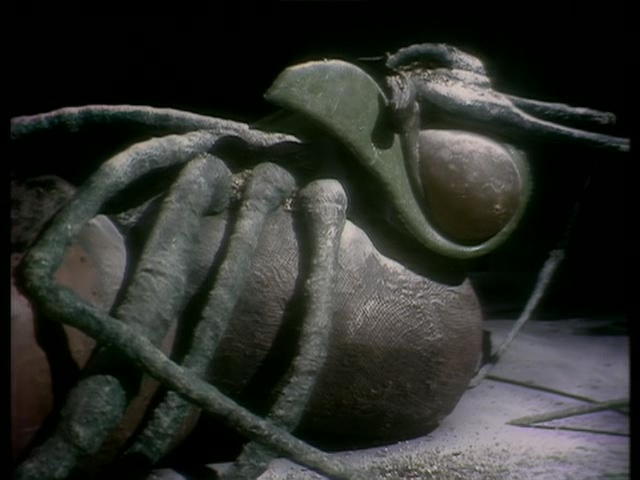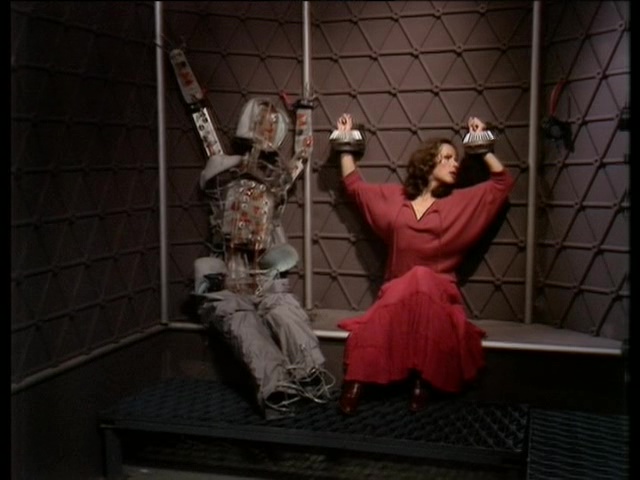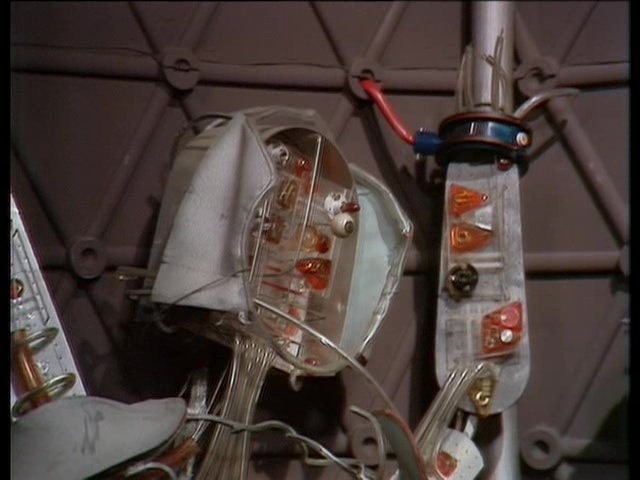
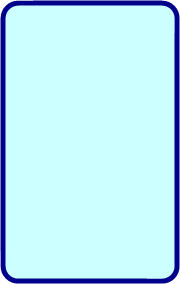
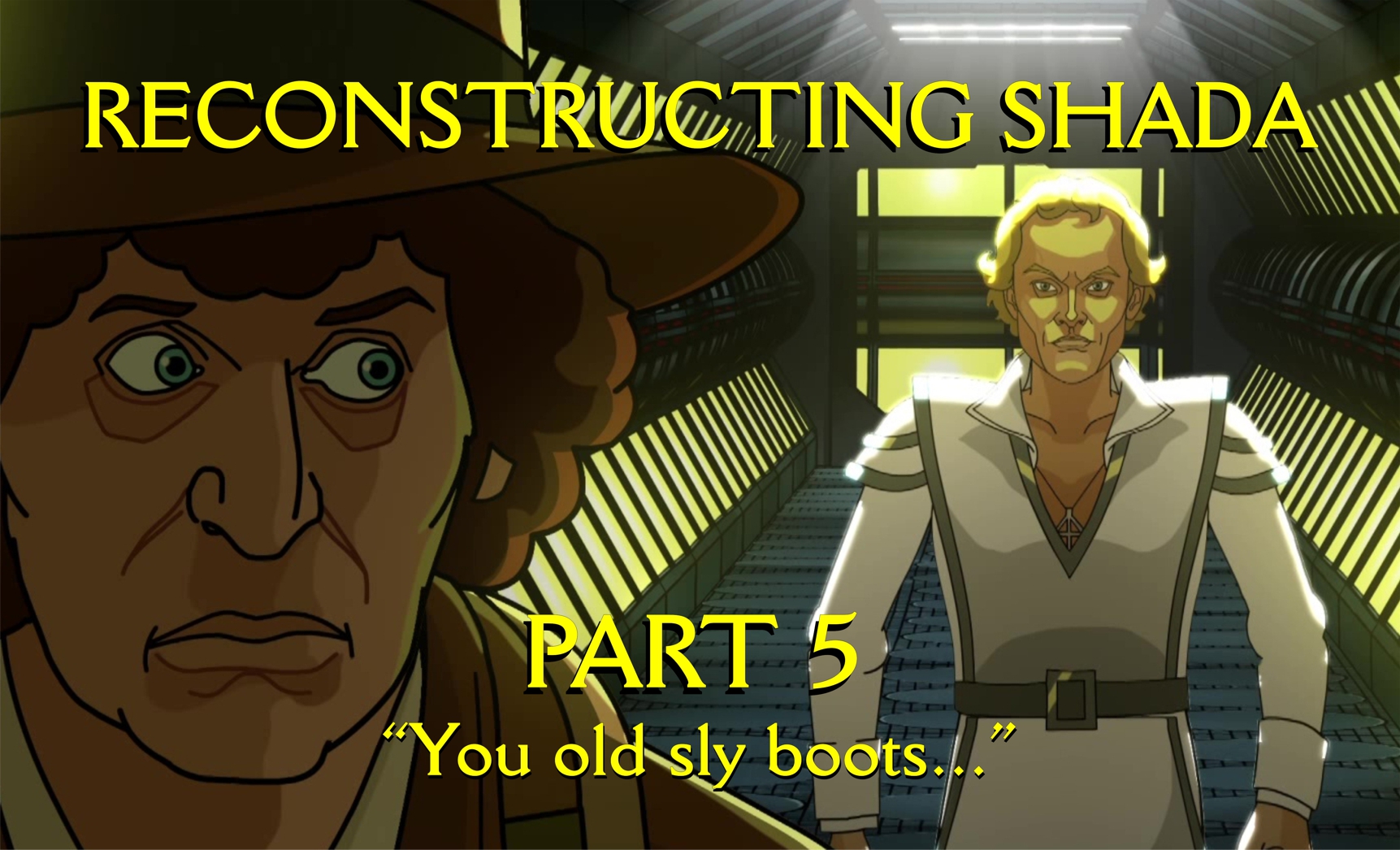
• CHARLES NORTON:
We recorded an additional bit of ADR for this scene - to dub over the footage originally shot back in 1979. We recorded Daniel Hill saying: "What are you doing here?" on 9th June 2017 at Audio Sorcery. However, for whatever reason, we eventually decided not to use this bit of ADR in the final programme at all. I can't remember why now. Perhaps I just decided the edit worked fine without it. I can't even remember exactly where in the scene I was thinking of inserting it. Regardless of the reason, it went unused. There are lots of other little bits of ADR peppered across Shada, of course (bits of 2017 audio dubbed over 1979 footage), but not here.
We recorded an additional bit of ADR for this scene - to dub over the footage originally shot back in 1979. We recorded Daniel Hill saying: "What are you doing here?" on 9th June 2017 at Audio Sorcery. However, for whatever reason, we eventually decided not to use this bit of ADR in the final programme at all. I can't remember why now. Perhaps I just decided the edit worked fine without it. I can't even remember exactly where in the scene I was thinking of inserting it. Regardless of the reason, it went unused. There are lots of other little bits of ADR peppered across Shada, of course (bits of 2017 audio dubbed over 1979 footage), but not here.


All timings in this article are taken from the 2017 master file for Shada. Whether you are watching the original 2017 DVD/BluRay; the 2021 Season 17 Blu-ray Collection box-set re-issue or the German-dubbed Polyband DVD/BluRay, the timings should still all match those cited here. It doesn't matter which edition you watch, as they should all use the same edit of the production. Of course, if you're watching the alternate 6-part special feature on the 2021 box-set or if you're watching the 1992 VHS compilation, then the timings won't match. So, if you are reading these viewing notes as you watch, make sure you're playing the right disc.
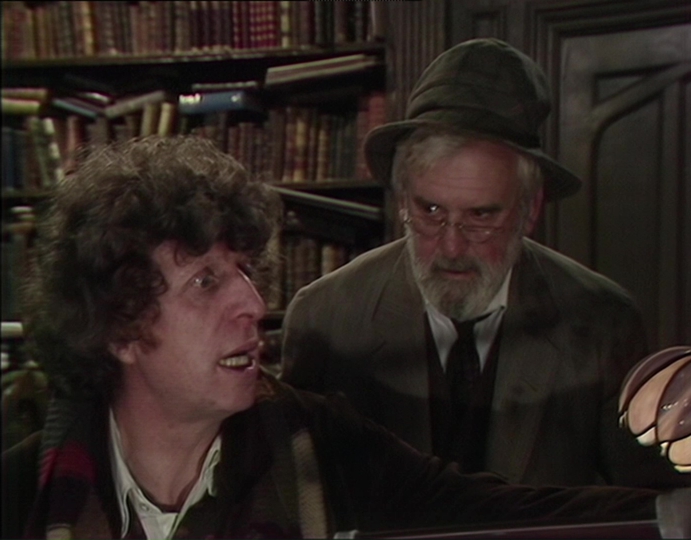
1:45:35 - The Doctor talks to Chronotis about his TARDIS
1:48:03 - We see Shada for the first time
• CHARLES NORTON:
Another glorious hand-painted element from Graham Bleathman here, for the exterior of Shada.
• RICHARD BIGNELL:
Graham's depiction of Shada closely matches the original model of the prison constucted in 1979. Among the hours of studio recordings that survive for the story, we have one a very brief shot of the model set-up against its green screen backing, lasting no more than two seconds! As typical of the period, most of the model shots were due to be recorded in the electronic studio rather than be pre-filmed, but although the Shada model was erected in the studio, none of the planned effect shots with it were committed to tape.
Another glorious hand-painted element from Graham Bleathman here, for the exterior of Shada.
• RICHARD BIGNELL:
Graham's depiction of Shada closely matches the original model of the prison constucted in 1979. Among the hours of studio recordings that survive for the story, we have one a very brief shot of the model set-up against its green screen backing, lasting no more than two seconds! As typical of the period, most of the model shots were due to be recorded in the electronic studio rather than be pre-filmed, but although the Shada model was erected in the studio, none of the planned effect shots with it were committed to tape.
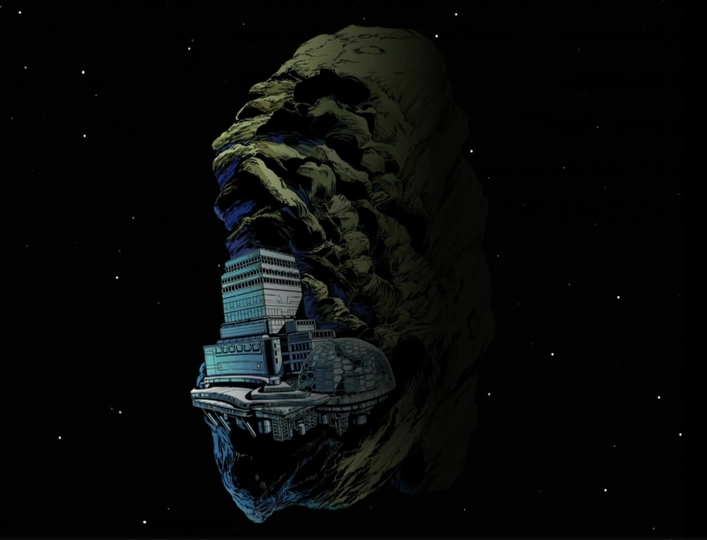
The original 1979 model of Shada
1:49:59 - K9 is trapped in the door
• CHARLES NORTON:
That little burbling sound K9 makes as he gets thumped by the closing door - we added that in. It's not part of the 1979 recording. Mark managed to find me an appropriate bit of audio from which he could sample the sound and he patched it in. Clearly evidence of a childish sense of humour from us both.
• MARK AYRES:
I believe that sound was actually on the generic K9 voice tape that Charles referred to earlier. I cannot remember if I sped it up a bit. We use it again later when K9 is picked up and thrown by the Krarg. Poor K9.
That little burbling sound K9 makes as he gets thumped by the closing door - we added that in. It's not part of the 1979 recording. Mark managed to find me an appropriate bit of audio from which he could sample the sound and he patched it in. Clearly evidence of a childish sense of humour from us both.
• MARK AYRES:
I believe that sound was actually on the generic K9 voice tape that Charles referred to earlier. I cannot remember if I sped it up a bit. We use it again later when K9 is picked up and thrown by the Krarg. Poor K9.
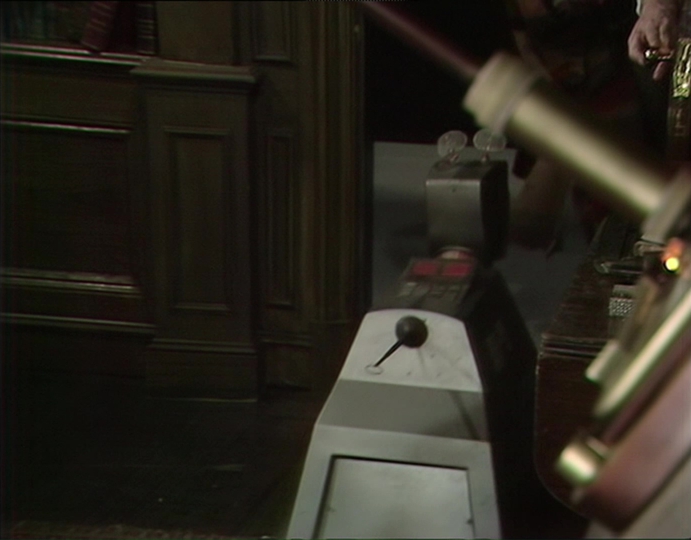
1:50:00 - Chronotis doesn't talk to the Doctor about Skagra
• CHARLES NORTON:
Almost all of the scenes that the character of Professor Chronotis needed to appear in were shot as planned back in 1979. The original intention back then was that Denis Carey would return to the studio for one final day's shooting toward the end of the month and that would then complete his commitments to the production. Of course, in the event, what actually happened was that production was shutdown around the middle of November and Denis Carey never got that final day in the studio.
Denis Carey died in 1986, leaving us with a certain amount of the production that we had to complete without him. This initially seemed like it might be quite a difficult problem to solve. However, as it turned out, the bulk of the remaining material wasn't actually all that difficult to sort out. Chronotis had so little dialogue in the final third of the story that it was mostly quite painless to simply remove any scripted material featuring the character and have the story still function perfectly well without it.
The first of the cuts falls at the 1:50:00 minute mark. Originally, as scripted, there was meant to be a short scene in one of Shada's corridors of Chronotis telling the Doctor that, "it is imperative we find him [Skagra] before he finds Salyavin." If Denis Carey has still been alive, I think I'd have recorded the scene, but without him, it seemed like poor-taste to attempt it using an impersonator.
Almost all of the scenes that the character of Professor Chronotis needed to appear in were shot as planned back in 1979. The original intention back then was that Denis Carey would return to the studio for one final day's shooting toward the end of the month and that would then complete his commitments to the production. Of course, in the event, what actually happened was that production was shutdown around the middle of November and Denis Carey never got that final day in the studio.
Denis Carey died in 1986, leaving us with a certain amount of the production that we had to complete without him. This initially seemed like it might be quite a difficult problem to solve. However, as it turned out, the bulk of the remaining material wasn't actually all that difficult to sort out. Chronotis had so little dialogue in the final third of the story that it was mostly quite painless to simply remove any scripted material featuring the character and have the story still function perfectly well without it.
The first of the cuts falls at the 1:50:00 minute mark. Originally, as scripted, there was meant to be a short scene in one of Shada's corridors of Chronotis telling the Doctor that, "it is imperative we find him [Skagra] before he finds Salyavin." If Denis Carey has still been alive, I think I'd have recorded the scene, but without him, it seemed like poor-taste to attempt it using an impersonator.
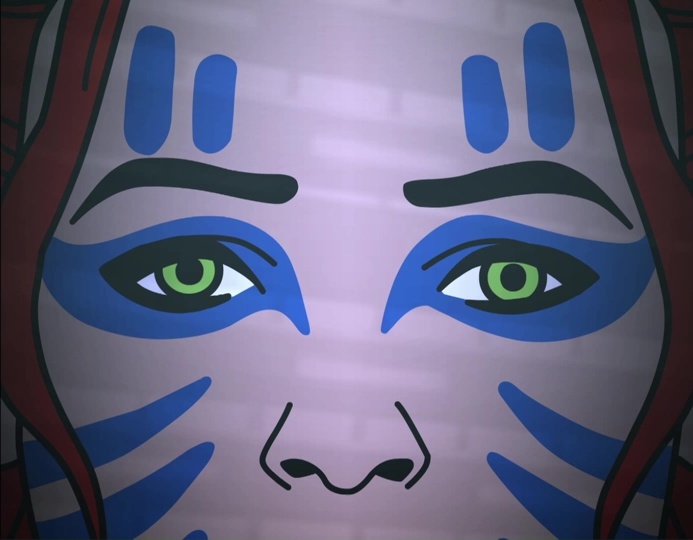
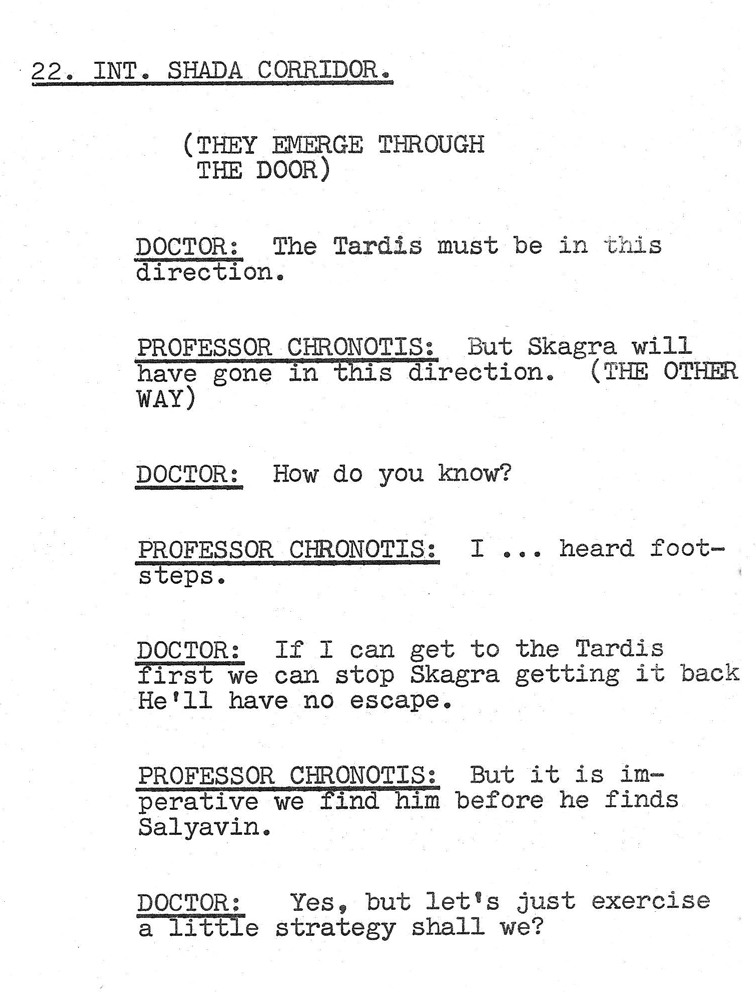
1:50:56 - One of the prisoners is awakened
• CHARLES NORTON:
At 1:50:56, one of the prisoners (Boedicea) is framed in a tight close-up, when suddenly her eyes pop open, bringing the scene to a close. At exactly that point, BBC America went to a commercial break. The programme resumed with the next scene of Clare and Chris on the sofa.
At 1:50:56, one of the prisoners (Boedicea) is framed in a tight close-up, when suddenly her eyes pop open, bringing the scene to a close. At exactly that point, BBC America went to a commercial break. The programme resumed with the next scene of Clare and Chris on the sofa.
1:51:34 - Chronotis doesn't continue to fret about Salyavin
• CHARLES NORTON:
Another short Chronotis scene that appears in the original script, but we chose not to record. Even if Denis Carey had still been around, I suspect I might still have cut this scene. It does rather slow things down at a crucial point and only really covers the same ground as the previous Chronotis scene. I think it might just be there to get the episode up to length. Interestingly, although the scene appears in the scripts for the abandoned four-part version of the story (drawn up for the cancelled 1981 broadcast), the scene is heavily trimmed down to just a few lines. In that version of the script, the scene (what little of it they left in) would have come early into Part 4.
Another short Chronotis scene that appears in the original script, but we chose not to record. Even if Denis Carey had still been around, I suspect I might still have cut this scene. It does rather slow things down at a crucial point and only really covers the same ground as the previous Chronotis scene. I think it might just be there to get the episode up to length. Interestingly, although the scene appears in the scripts for the abandoned four-part version of the story (drawn up for the cancelled 1981 broadcast), the scene is heavily trimmed down to just a few lines. In that version of the script, the scene (what little of it they left in) would have come early into Part 4.
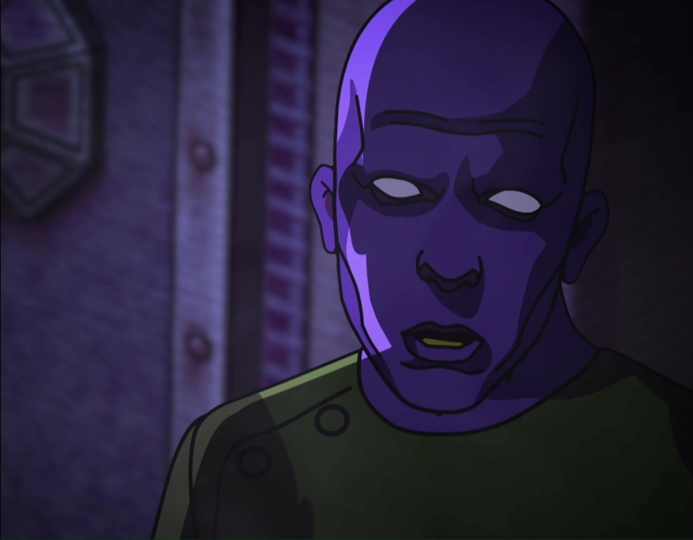
1:51:40 - An alien prisoner wakes up
• CHARLES NORTON:
This shot with the 'camera' starting high and pitching down into the scene is many times more complex than it might appear. All the characters are flat 2D artworks existing only in one plane. Therefore, in order to have the character seen in three dimensions like this, you have to redraw it for each and every frame and track the relative position of that character as the camera comes down - without it looking like the character is changing physically as you do so. It's stupidly difficult. We really didn't have to make it that difficult, but I'm quite pleased we did. It was one of the last shots we animated and was completed entirely by lead animator and supervisor, AnneMarie Walsh.
This shot with the 'camera' starting high and pitching down into the scene is many times more complex than it might appear. All the characters are flat 2D artworks existing only in one plane. Therefore, in order to have the character seen in three dimensions like this, you have to redraw it for each and every frame and track the relative position of that character as the camera comes down - without it looking like the character is changing physically as you do so. It's stupidly difficult. We really didn't have to make it that difficult, but I'm quite pleased we did. It was one of the last shots we animated and was completed entirely by lead animator and supervisor, AnneMarie Walsh.
1:52:14 - Skagra spreads his arms to protect the tomb
• CHARLES NORTON:
Another really complex bit of work here. That shading (with the light spilling around his body as he moves under the lamp) is all done frame by frame by Adrian Salmon.
• ADRIAN SALMON:
Skagra tells the others to “keep away” as he stands in front and blocks Salyavin’s cryogenic cell, with outstretched arms. I felt that this shot might benefit with someup-lighting (a technique used extensively in b/w horror and noir films). It was easily achieved using a layer set to darken for the shadows, which were painted darkest on the upper most parts of the face and arms. A final layer then added the white highlights catching Skagra’s costume.
Another really complex bit of work here. That shading (with the light spilling around his body as he moves under the lamp) is all done frame by frame by Adrian Salmon.
• ADRIAN SALMON:
Skagra tells the others to “keep away” as he stands in front and blocks Salyavin’s cryogenic cell, with outstretched arms. I felt that this shot might benefit with someup-lighting (a technique used extensively in b/w horror and noir films). It was easily achieved using a layer set to darken for the shadows, which were painted darkest on the upper most parts of the face and arms. A final layer then added the white highlights catching Skagra’s costume.
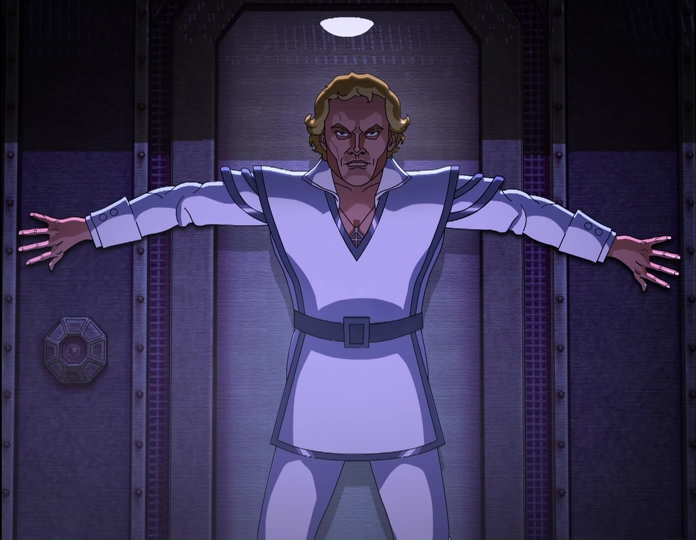
1:52:45 - Chronotis' eyes glow
• CHARLES NORTON:
This isn't remotely as scripted, I'm afraid. In the original rehearsal scripts for this scene, Skagra asks: "Where is Salyavin?" And Chronotis replies "I escaped centuries ago." There was obviously no way we'd ever manage to put together any audio of Denis Carey saying that. So, I came up with the glowing eyes, to try to convey the same thing. The sadness of the body language and Mark Ayres' rising score hopefully sells the rest.
This isn't remotely as scripted, I'm afraid. In the original rehearsal scripts for this scene, Skagra asks: "Where is Salyavin?" And Chronotis replies "I escaped centuries ago." There was obviously no way we'd ever manage to put together any audio of Denis Carey saying that. So, I came up with the glowing eyes, to try to convey the same thing. The sadness of the body language and Mark Ayres' rising score hopefully sells the rest.
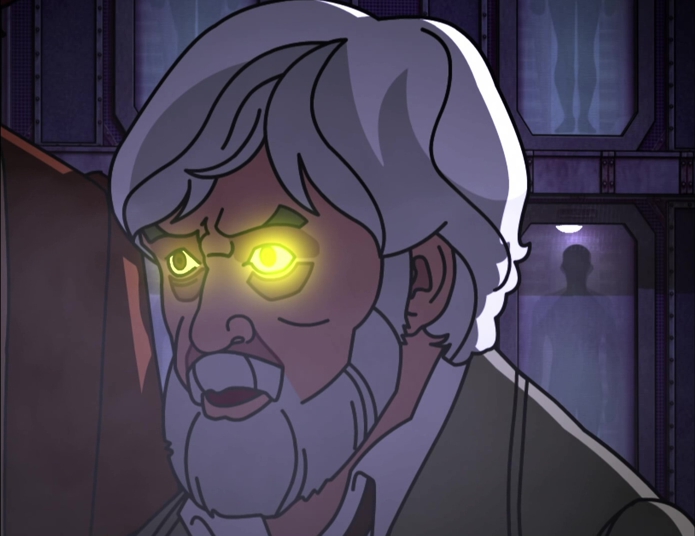
1:53:36 - Salyavin is revealed
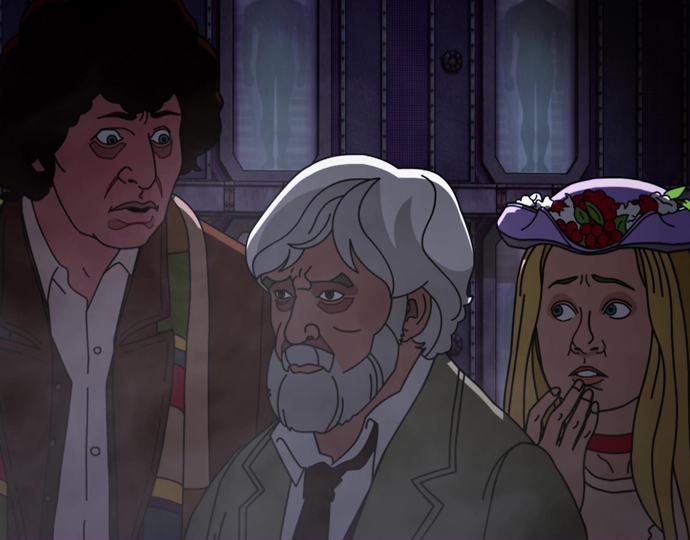
• CHARLES NORTON:
We mostly just cut any scripted material featuring Chronotis, for the reasons explained above. I didn't want to employ a soundalike pretending to be Denis Carey as it seemed somehow disrespectful to the original actor and probably would have been a bit too obvious anyway.
These cuts were normally quite painless to achieve, as Chronotis has so very little to do in the latter third of the story. However, then we came to the scene in which Salyavin is revealed. There was no way the scene could be removed if we still wanted the story to make sense and there was no way we could remove the character of Chronotis from the scene either, as it was around him that the whole scene revolved. The solution was to largely rewrite the scene, moving dialogue around and restructuring, so that Chronotis could communicate what he needed to without needing to speak. Or at least, largely without needing to speak. He still needed to be able to say something, of course. It didn't have to perfectly fit the script, as we could always rewrite the other characters' dialogue around him. However, we did need something. We couldn't have him totally wordless, without the scene feeling very strange indeed.
Denis Carey had returned to Doctor Who the following season after Shada to appear in one more Doctor Who episode with Tom Baker - 1981's The Keeper of Traken (where he played the title character). He's not in the story for very long, only in Part 1, but the episode gave us a solution to our problem. “Well guessed, Doctor” was one line Carey had as the Keeper that I felt I could probably weave into the script to make sense of our scene in Shada - and I ended up reworking our whole scene around that.
The original plan was to lift the audio from the first episode of The Keeper of Traken and then treat it to match the audio of Shada. However, in the end, Mark Ayres was able to go back to an early unmixed production tape from the story and lift the completely clean audio from there, making it much easier to blend in. The final scene isn't what would have been shot back in 1979, of course and it's not really what Douglas Adams wrote. However, it does make sense. In fact, Carey's detached delivery as the Keeper actually suits the mood of the Shada scene very well. It actually adds a bit of pathos to the whole thing that was clearly never in Carey's mind when he said the line, but which naturally arises from it being placed into this new context. We animated the character to fit in with that (with character animation from Ana Garcia Sebastia). Chronotis looks dejected and defeated, as everything he's tried to make of his life crumbles apart in front of him. I'm not sure we'd have done it that way, had Carey's performance in The Keeper of Traken not suggested it.
We mostly just cut any scripted material featuring Chronotis, for the reasons explained above. I didn't want to employ a soundalike pretending to be Denis Carey as it seemed somehow disrespectful to the original actor and probably would have been a bit too obvious anyway.
These cuts were normally quite painless to achieve, as Chronotis has so very little to do in the latter third of the story. However, then we came to the scene in which Salyavin is revealed. There was no way the scene could be removed if we still wanted the story to make sense and there was no way we could remove the character of Chronotis from the scene either, as it was around him that the whole scene revolved. The solution was to largely rewrite the scene, moving dialogue around and restructuring, so that Chronotis could communicate what he needed to without needing to speak. Or at least, largely without needing to speak. He still needed to be able to say something, of course. It didn't have to perfectly fit the script, as we could always rewrite the other characters' dialogue around him. However, we did need something. We couldn't have him totally wordless, without the scene feeling very strange indeed.
Denis Carey had returned to Doctor Who the following season after Shada to appear in one more Doctor Who episode with Tom Baker - 1981's The Keeper of Traken (where he played the title character). He's not in the story for very long, only in Part 1, but the episode gave us a solution to our problem. “Well guessed, Doctor” was one line Carey had as the Keeper that I felt I could probably weave into the script to make sense of our scene in Shada - and I ended up reworking our whole scene around that.
The original plan was to lift the audio from the first episode of The Keeper of Traken and then treat it to match the audio of Shada. However, in the end, Mark Ayres was able to go back to an early unmixed production tape from the story and lift the completely clean audio from there, making it much easier to blend in. The final scene isn't what would have been shot back in 1979, of course and it's not really what Douglas Adams wrote. However, it does make sense. In fact, Carey's detached delivery as the Keeper actually suits the mood of the Shada scene very well. It actually adds a bit of pathos to the whole thing that was clearly never in Carey's mind when he said the line, but which naturally arises from it being placed into this new context. We animated the character to fit in with that (with character animation from Ana Garcia Sebastia). Chronotis looks dejected and defeated, as everything he's tried to make of his life crumbles apart in front of him. I'm not sure we'd have done it that way, had Carey's performance in The Keeper of Traken not suggested it.
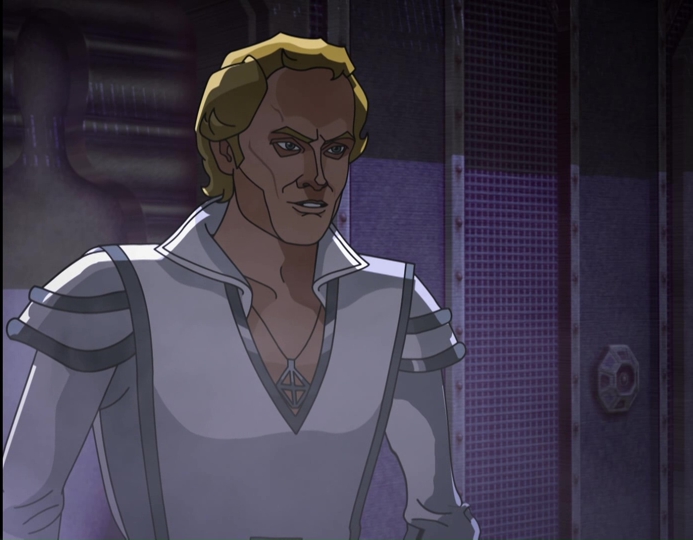
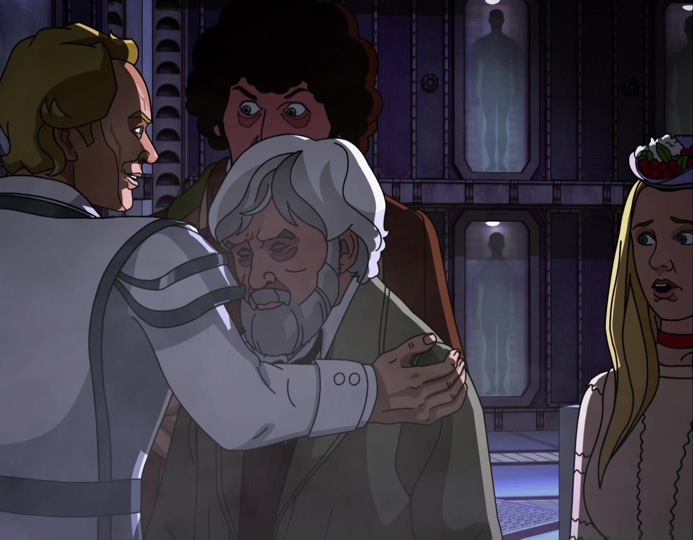
1:54:18 - The universal mind
• CHARLES NORTON:
That line of Skagra's about the universal mind. It really feels like such an obvious end of episode cliff-hanger, doesn't it? Strange thing is, it never has been. It comes very close to the end of what would have been Part 5 in the rehearsal script for the originally proposed six-part version of the story. However, it's not the cliff-hanger. That comes quite a bit later. And it's buried about a third of the way into Part 4 of the scripts for the proposed four-part version.
That line of Skagra's about the universal mind. It really feels like such an obvious end of episode cliff-hanger, doesn't it? Strange thing is, it never has been. It comes very close to the end of what would have been Part 5 in the rehearsal script for the originally proposed six-part version of the story. However, it's not the cliff-hanger. That comes quite a bit later. And it's buried about a third of the way into Part 4 of the scripts for the proposed four-part version.
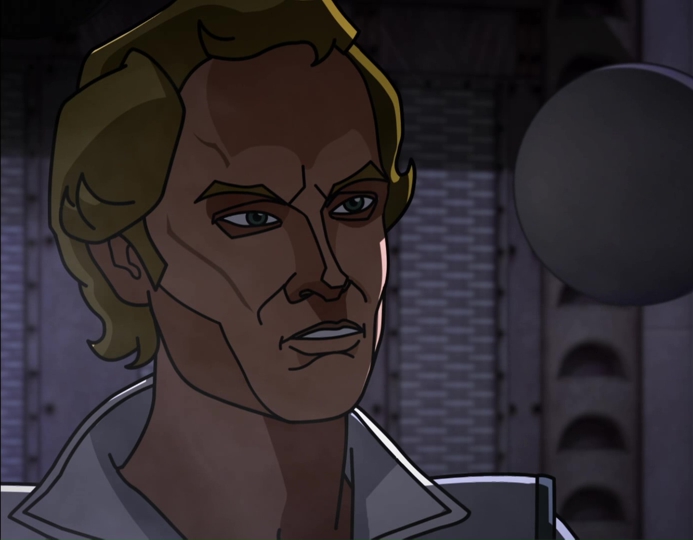
1:54:27 - Chronotis lies face down
• CHARLES NORTON:
The characters don't move in this shot. That's because they're a static artwork element drawn in pencil and ink by Martin Geraghty and coloured by Adrian Salmon. They spent a lot of time on it and it looks great. Unfortunately, I neglected to tell Martin that Chronotis had fallen face down in an (already completed) earlier shot. So, Martin ended up working incredibly hard on this beautiful piece of art of Chronotis lying face up. Only for me to then have to ask him if he could do it all over again with Chronotis lying face down. Remarkably, he didn't hit me.
The characters don't move in this shot. That's because they're a static artwork element drawn in pencil and ink by Martin Geraghty and coloured by Adrian Salmon. They spent a lot of time on it and it looks great. Unfortunately, I neglected to tell Martin that Chronotis had fallen face down in an (already completed) earlier shot. So, Martin ended up working incredibly hard on this beautiful piece of art of Chronotis lying face up. Only for me to then have to ask him if he could do it all over again with Chronotis lying face down. Remarkably, he didn't hit me.
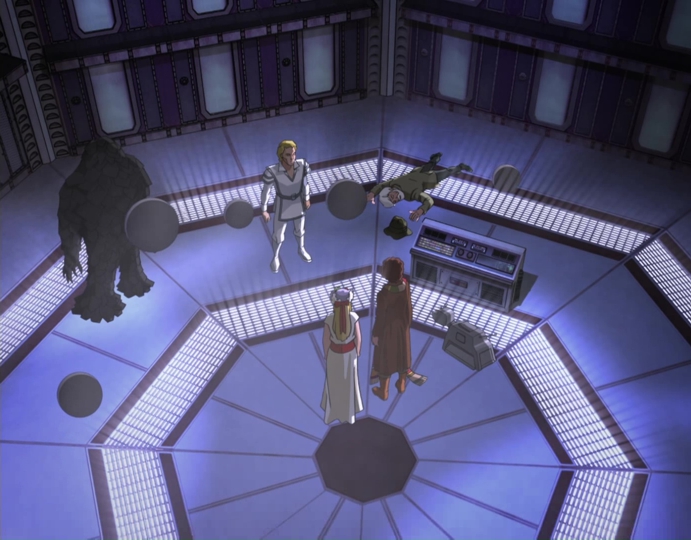
1:55:34 - A Krarg rises up
• CHARLES NORTON:
There's an amazingly subtle visual in-joke here, that's extremely hard to spot. Rob Ritchie put it in. Can you spot it? No, I'm not telling you what it is.
There's an amazingly subtle visual in-joke here, that's extremely hard to spot. Rob Ritchie put it in. Can you spot it? No, I'm not telling you what it is.
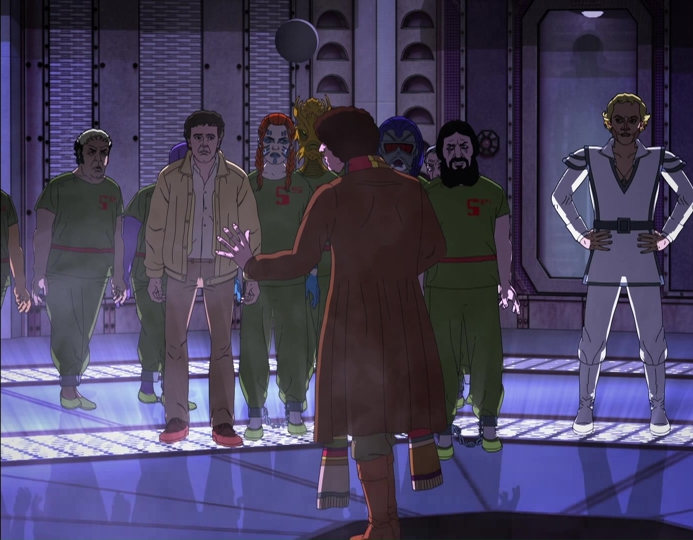
1:55:02 - A Krarg rises up
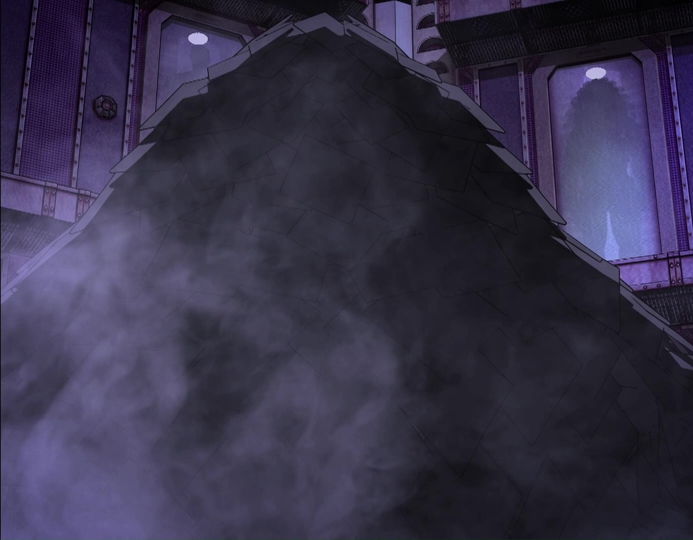
• CHARLES NORTON:
For those of you trying to keep track, this is the point in the narrative where the end credits to Part 5 would probably have crashed in, had the story been completed as planned back in 1979. I say probably. We can't be 100% certain, as nobody ever created a camera script for this part of the story. So, we don't really know how Pennant Roberts would have handled it. Still, this is where Douglas Adams puts the cliff-hanger in his rehearsal script.
For those of you trying to keep track, this is the point in the narrative where the end credits to Part 5 would probably have crashed in, had the story been completed as planned back in 1979. I say probably. We can't be 100% certain, as nobody ever created a camera script for this part of the story. So, we don't really know how Pennant Roberts would have handled it. Still, this is where Douglas Adams puts the cliff-hanger in his rehearsal script.
1:55:52 - K9 enters the room
• CHARLES NORTON:
Yes, that cutaway of K9 coming in is a new one that we shot at IMG studios. No, it doesn't quite work. Sorry. We tried.
Yes, that cutaway of K9 coming in is a new one that we shot at IMG studios. No, it doesn't quite work. Sorry. We tried.
1:57:35 - Skagra not in the TARDIS
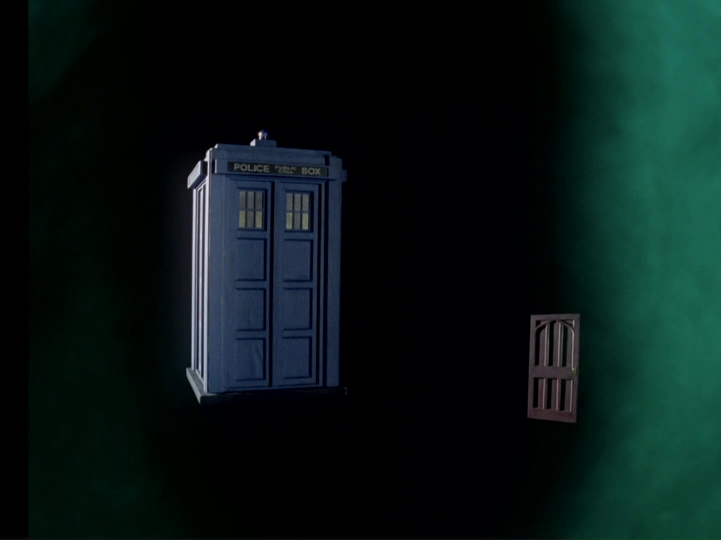
• CHARLES NORTON:
The original rehearsal script contained some additional material prior to this TARDIS scene. In the material, Skagra briefly talks to a Krarg before entering the TARDIS. We decided not to record this short section and instead cut straight to the scene with them already inside the TARDIS. It seems that the original production team may have been thinking along similar lines. The material is not included in either the 1979 camera script for the six-part version of Shada nor the corresponding 1980 camera script for four-part version.
The original rehearsal script contained some additional material prior to this TARDIS scene. In the material, Skagra briefly talks to a Krarg before entering the TARDIS. We decided not to record this short section and instead cut straight to the scene with them already inside the TARDIS. It seems that the original production team may have been thinking along similar lines. The material is not included in either the 1979 camera script for the six-part version of Shada nor the corresponding 1980 camera script for four-part version.
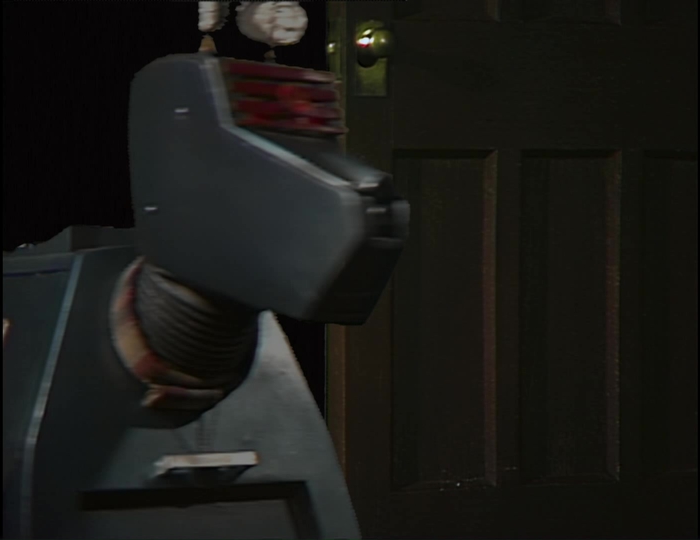
1:58:30 - Two TARDISes in the vortex
• CHARLES NORTON:
All of the shots of the two TARDISes in the void were filmed on the sound stage at Halliford Studios on 9th August 2017. That's a miniature police box built by Jonathan Sellers and a miniature door built by Mike Tucker. The whole scene was filmed upside down against black, with the suspension wires for the models hanging from the bottoms of the props. In order to get the very slow movement of the rotating TARDIS, the model was slowly spun on its wire and then allowed to gently rotate to a stop. Only when it was a few seconds from slowing to a total stop, did we roll the camera. Thus getting a nice gentle rotation, free of wobble.
All of the shots of the two TARDISes in the void were filmed on the sound stage at Halliford Studios on 9th August 2017. That's a miniature police box built by Jonathan Sellers and a miniature door built by Mike Tucker. The whole scene was filmed upside down against black, with the suspension wires for the models hanging from the bottoms of the props. In order to get the very slow movement of the rotating TARDIS, the model was slowly spun on its wire and then allowed to gently rotate to a stop. Only when it was a few seconds from slowing to a total stop, did we roll the camera. Thus getting a nice gentle rotation, free of wobble.
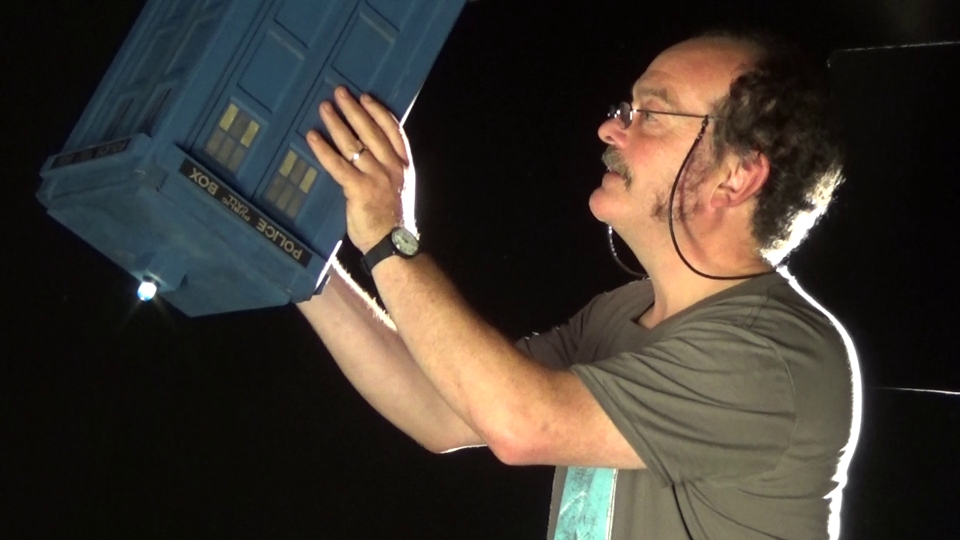
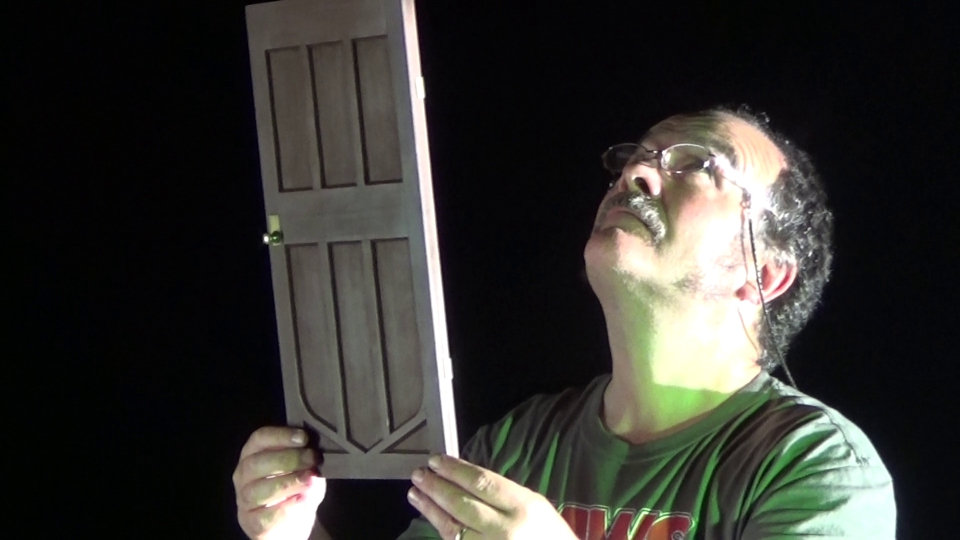
Mike Tucker hangs the TARDIS and the study door from suspension wires at Halliford Studios on 9th August, 2017 (Image © Charles Norton)
• MIKE TUCKER:
The TARDIS model that we used was slightly larger than the one that Dave Havard and his team had intended to use. Charles had emailed me a picture of beautiful model of the Season 17 TARDIS and wondered if there was any chance of getting hold of it for the shoot. After a bit of internet digging I discovered that it had been made by a model maker named Jonathan Sellers, who had quite a reputation for accurate TARDIS miniatures, and although he no longer had that particular model, he was willing to build us a new one.
The TARDIS was rigged with a variable speed flashing light circuit, and the miniature suspended upside down for the flying shots, a sleight of hand trick to aid with the disguising of the suspension wires. Skagra’s spacecraft miniature was flown in a similar manner.
• RICHARD BIGNELL:
TARDIS builder Jonathan Sellers has been building models for many years and back in March 1975, during the transmission of Genesis of the Daleks, he had a whole range of his work shown on Blue Peter. The clip from the programme with Jonathan's models appears in full on the Season 12 Collection (Disc 4).
The TARDIS model that we used was slightly larger than the one that Dave Havard and his team had intended to use. Charles had emailed me a picture of beautiful model of the Season 17 TARDIS and wondered if there was any chance of getting hold of it for the shoot. After a bit of internet digging I discovered that it had been made by a model maker named Jonathan Sellers, who had quite a reputation for accurate TARDIS miniatures, and although he no longer had that particular model, he was willing to build us a new one.
The TARDIS was rigged with a variable speed flashing light circuit, and the miniature suspended upside down for the flying shots, a sleight of hand trick to aid with the disguising of the suspension wires. Skagra’s spacecraft miniature was flown in a similar manner.
• RICHARD BIGNELL:
TARDIS builder Jonathan Sellers has been building models for many years and back in March 1975, during the transmission of Genesis of the Daleks, he had a whole range of his work shown on Blue Peter. The clip from the programme with Jonathan's models appears in full on the Season 12 Collection (Disc 4).
• CHARLES NORTON:
All this was again shot in 16mm film on the Arri, with a very hard directional key-light. The two models were actually filmed separately, with the two bits of film being composited together afterward by Michael Dinsdale.
The sequence was planned to play against a totally blank jet-black void. However, Michael added some columns of steam in post-production and they seemed to work. So, we left them in.
All this was again shot in 16mm film on the Arri, with a very hard directional key-light. The two models were actually filmed separately, with the two bits of film being composited together afterward by Michael Dinsdale.
The sequence was planned to play against a totally blank jet-black void. However, Michael added some columns of steam in post-production and they seemed to work. So, we left them in.
1:58:51 - Skagra not detecting something wrong in the TARDIS
• CHARLES NORTON:
Another cut scene here. The original rehearsal script has a scene of Skagra in the TARDIS, just after the Doctor throws the switch. Skagra detects something wrong in the vortex outside and correctly deduces that it's the Doctor. We did actually record the audio for this scene with Chris Neame at Motivation Sound on 26th June 2017. However, in the end, we never used it. In fact, I'm fairly sure that I'd already decided not to include the scene long before storyboarding began. Which does beg the question why I got Chris to record something I never intended to use. Perhaps I failed to delete it from the recording scripts ahead of the studio booking. I'm afraid I don't really remember now.
It was cut for pacing reasons and also to avoid cutting away from what was otherwise a nice big chunk of live-action material.
Incidentally, because we cut this scene, we had to then swap the order of the next two scenes, to avoid a jump-cut. It doesn't make a lot of difference to the narrative flow though, as one of the scenes only lasts a few seconds anyway. You can listen to the cut scene in the deleted scenes feature on the release.
Another cut scene here. The original rehearsal script has a scene of Skagra in the TARDIS, just after the Doctor throws the switch. Skagra detects something wrong in the vortex outside and correctly deduces that it's the Doctor. We did actually record the audio for this scene with Chris Neame at Motivation Sound on 26th June 2017. However, in the end, we never used it. In fact, I'm fairly sure that I'd already decided not to include the scene long before storyboarding began. Which does beg the question why I got Chris to record something I never intended to use. Perhaps I failed to delete it from the recording scripts ahead of the studio booking. I'm afraid I don't really remember now.
It was cut for pacing reasons and also to avoid cutting away from what was otherwise a nice big chunk of live-action material.
Incidentally, because we cut this scene, we had to then swap the order of the next two scenes, to avoid a jump-cut. It doesn't make a lot of difference to the narrative flow though, as one of the scenes only lasts a few seconds anyway. You can listen to the cut scene in the deleted scenes feature on the release.
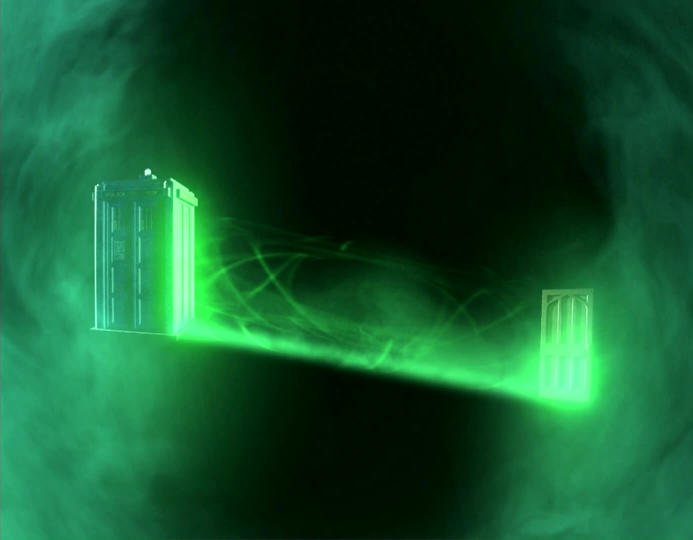
1:58:55 - A corridor of light appears between the two ships
• MIKE TUCKER:
Day two of the shoot concentrated on the blue screen photography of both the spacecraft and Skagra’s sphere, before moving onto shots of the Doctor’s and Professor Chronotis’ TARDISes in the time vortex. These sequences were shot against black, with an interactive flickering light effect.
• CHARLES NORTON:
The light corridor is a combination of practical in-camera effects and CGI. During filming, we had a single green spotlight pointed at a piece of shiny metallic mirrorlon. We used this to reflect a pattern of rippled green light onto one side of the model. When filming the police box miniature, we reflected the light onto one side of the model and when filming the door miniature, we reflected the light onto the other side of the model. So, that when the two piece of film were composited together, you had two ends of a light corridor, with the green light spilling over the surface of each model.
Michael Dinsdale matched the colour of the practical light and then added the tunnel effect over the top, joining together the two practical light spills on the models themselves. It's very subtle, but the way the light follows the contours of the two objects makes it seem less like the effect is just pasted on over the top of the footage. The overall effect, is designed to mimic a similar effects shot seen in the 1979 Doctor Who story, The Horns of Nimon.
Day two of the shoot concentrated on the blue screen photography of both the spacecraft and Skagra’s sphere, before moving onto shots of the Doctor’s and Professor Chronotis’ TARDISes in the time vortex. These sequences were shot against black, with an interactive flickering light effect.
• CHARLES NORTON:
The light corridor is a combination of practical in-camera effects and CGI. During filming, we had a single green spotlight pointed at a piece of shiny metallic mirrorlon. We used this to reflect a pattern of rippled green light onto one side of the model. When filming the police box miniature, we reflected the light onto one side of the model and when filming the door miniature, we reflected the light onto the other side of the model. So, that when the two piece of film were composited together, you had two ends of a light corridor, with the green light spilling over the surface of each model.
Michael Dinsdale matched the colour of the practical light and then added the tunnel effect over the top, joining together the two practical light spills on the models themselves. It's very subtle, but the way the light follows the contours of the two objects makes it seem less like the effect is just pasted on over the top of the footage. The overall effect, is designed to mimic a similar effects shot seen in the 1979 Doctor Who story, The Horns of Nimon.
• CHARLES NORTON:
Okay, that's not Tom. However, it's not CGI either. It's a bit more involved than that. The background of the shot is, of course, one of Mike's model shots, as outlined above. As Mike explains...
• MIKE TUCKER:
The sequences were framed so that the images could be extracted for compositing with footage of Tom Baker’s body double.
• CHARLES NORTON:
We cast Tim Bentinck to body-double for the Doctor. As previously mentioned, he has a similar build to Tom and really made an excellent stand-in. We also hired a replica of Tom Baker's costume from the (then in the process of being shutdown) Doctor Who Experience in Cardiff Bay. Unfortunately, we discovered that Tim has quite amazingly large feet (size 12), so we had to purchase some new boots for him, as the ones we already had were far too small. We also bought a new pair of trousers for the costume - which due to a slight miscalculation ended up being massively too short, barely coming up to Tim's knees. Happily however, the hems were covered by the tops of the boots, so we got away with it. With Tim Bentinck suitably kitted out as a 1970s era Tom Baker, we then (rather cruelly) put a bag on his head.
Although Tim is a great match for Tom's stature and build, he facially looks nothing like him. We therefore, had Tim wear a bright green stocking mask on his head for all the material we shot with him. This made it easier for us to digitally remove Tim's head in post-production and replace it with Tom's head. Tim acted out all the material we needed against a green screen at IMG Studios on 13th September 2017. So, in the finished programme, what you're actually looking at isn't Tom Baker at all. It’s Tim Bentinck dressed as Tom Baker crawling over a concrete studio floor with a green bag on his head.
Okay, that's not Tom. However, it's not CGI either. It's a bit more involved than that. The background of the shot is, of course, one of Mike's model shots, as outlined above. As Mike explains...
• MIKE TUCKER:
The sequences were framed so that the images could be extracted for compositing with footage of Tom Baker’s body double.
• CHARLES NORTON:
We cast Tim Bentinck to body-double for the Doctor. As previously mentioned, he has a similar build to Tom and really made an excellent stand-in. We also hired a replica of Tom Baker's costume from the (then in the process of being shutdown) Doctor Who Experience in Cardiff Bay. Unfortunately, we discovered that Tim has quite amazingly large feet (size 12), so we had to purchase some new boots for him, as the ones we already had were far too small. We also bought a new pair of trousers for the costume - which due to a slight miscalculation ended up being massively too short, barely coming up to Tim's knees. Happily however, the hems were covered by the tops of the boots, so we got away with it. With Tim Bentinck suitably kitted out as a 1970s era Tom Baker, we then (rather cruelly) put a bag on his head.
Although Tim is a great match for Tom's stature and build, he facially looks nothing like him. We therefore, had Tim wear a bright green stocking mask on his head for all the material we shot with him. This made it easier for us to digitally remove Tim's head in post-production and replace it with Tom's head. Tim acted out all the material we needed against a green screen at IMG Studios on 13th September 2017. So, in the finished programme, what you're actually looking at isn't Tom Baker at all. It’s Tim Bentinck dressed as Tom Baker crawling over a concrete studio floor with a green bag on his head.
2:00:37 - The Doctor crawls across to his TARDIS
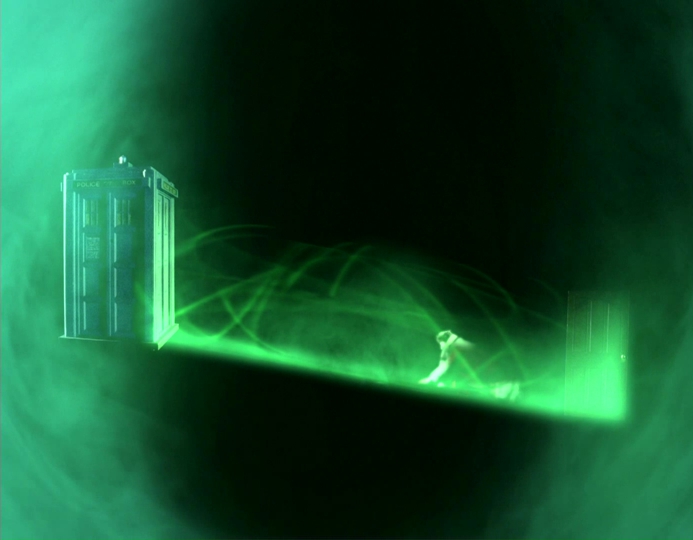
Once we had all our footage of Tim, we then digitally removed the green stocking head - ready to replace it with Tom Baker's head circa 1979. Problem was, we didn't actually have Tom Baker's head circa 1979. Tom had left that back in 1979. So, we needed to have a stand-in for Tom's head, as well as his body.
This is where visual effects sculptor Philip Robinson was able to help us. An extremely talented sculptor, Philip was able to provide us with a life-size bust of Tom's head, based on how he looked in the 1970s. This was sculpted in clay, cast in silicone rubber and then painted to match reference photos. The eyes were glass and the hair was simply a shop-bought nylon wig that was placed on top of the bust. Rather disturbingly, this extremely realistic severed head then spent the next few days sat in a small cardboard box travelling around Sunderland on the back-seat of Rob Ritchie's car where, if nothing else, it would doubtless have proven highly successful in deterring any passing car-thieves. Rob eventually brought the head down to a photographic studio, where it was mounted on a suitable suspension device (a wooden mug tree) and photographed from all the angles we might need. This was done on 11th October 2017 and was officially the final day of shooting on Shada - after over 38 years of (occasional) production.
The photos of Tom's unsettlingly realistic rubber head were then composited (by Michael Dinsdale) onto the 'headless' footage we had of Tim Bentinck and this effectively completed the shots. We had all the footage we needed of a 1970s live-action Tom crawling through deep space, without ever actually needing Tom to do anything at all.
• RICHARD BIGNELL:
It's worth pointing out here that the effect of the two TARDISes in the vortex was actually recorded back in 1979 during one of the studio days, although none of the material showing the Doctor trying to cross between the two was committed to tape.
This is where visual effects sculptor Philip Robinson was able to help us. An extremely talented sculptor, Philip was able to provide us with a life-size bust of Tom's head, based on how he looked in the 1970s. This was sculpted in clay, cast in silicone rubber and then painted to match reference photos. The eyes were glass and the hair was simply a shop-bought nylon wig that was placed on top of the bust. Rather disturbingly, this extremely realistic severed head then spent the next few days sat in a small cardboard box travelling around Sunderland on the back-seat of Rob Ritchie's car where, if nothing else, it would doubtless have proven highly successful in deterring any passing car-thieves. Rob eventually brought the head down to a photographic studio, where it was mounted on a suitable suspension device (a wooden mug tree) and photographed from all the angles we might need. This was done on 11th October 2017 and was officially the final day of shooting on Shada - after over 38 years of (occasional) production.
The photos of Tom's unsettlingly realistic rubber head were then composited (by Michael Dinsdale) onto the 'headless' footage we had of Tim Bentinck and this effectively completed the shots. We had all the footage we needed of a 1970s live-action Tom crawling through deep space, without ever actually needing Tom to do anything at all.
• RICHARD BIGNELL:
It's worth pointing out here that the effect of the two TARDISes in the vortex was actually recorded back in 1979 during one of the studio days, although none of the material showing the Doctor trying to cross between the two was committed to tape.
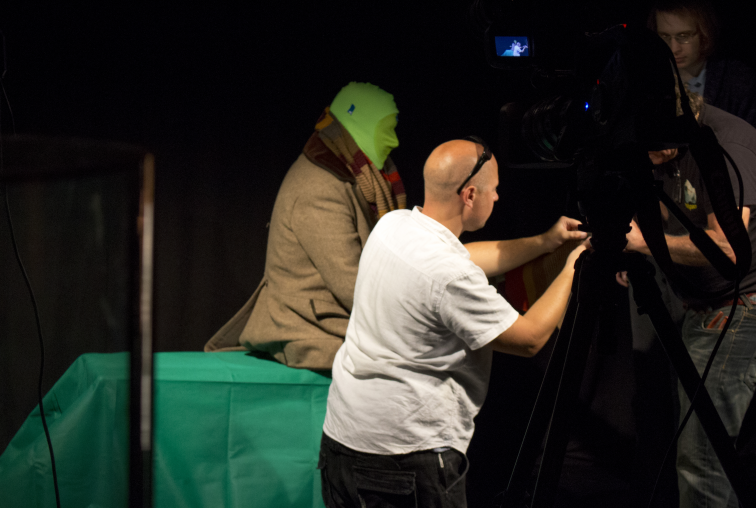
Above: Green-bagged Tim Bentinck at IGM Studios on 13th September, 2017
Left: Bust of Tom Baker, created by Philip Robinson (Images © Rob Ritchie)
Left: Bust of Tom Baker, created by Philip Robinson (Images © Rob Ritchie)
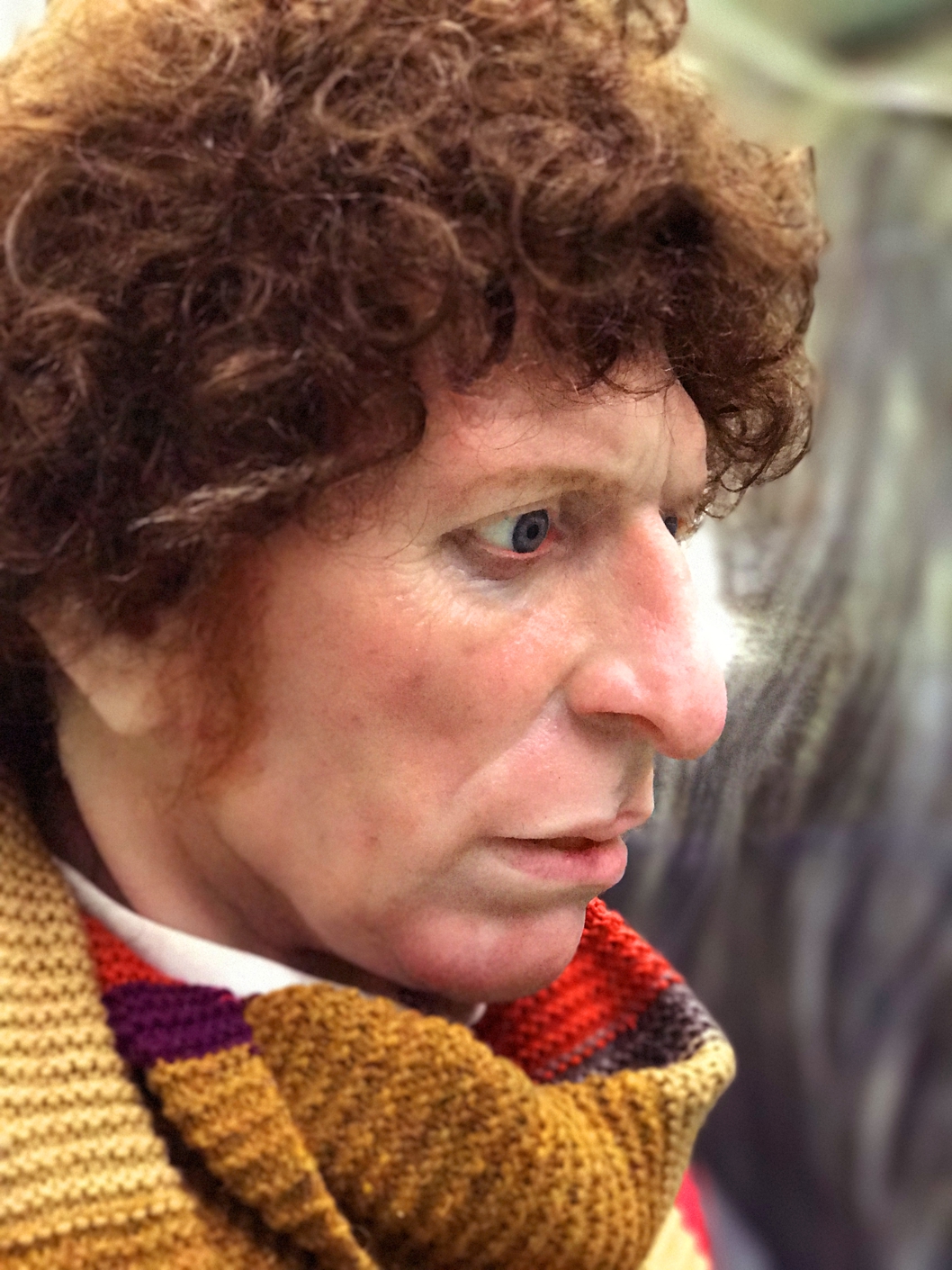
2:01:07 - The Doctor continues to crawl
• CHARLES NORTON:
Tim was actually crawling on the spot here. The studio (and the green-screen) wasn't big enough to have him cover any distance. Michael Dinsdale simply moved the footage across the screen as needed to convey the impression of him moving forward.
Tim was actually crawling on the spot here. The studio (and the green-screen) wasn't big enough to have him cover any distance. Michael Dinsdale simply moved the footage across the screen as needed to convey the impression of him moving forward.
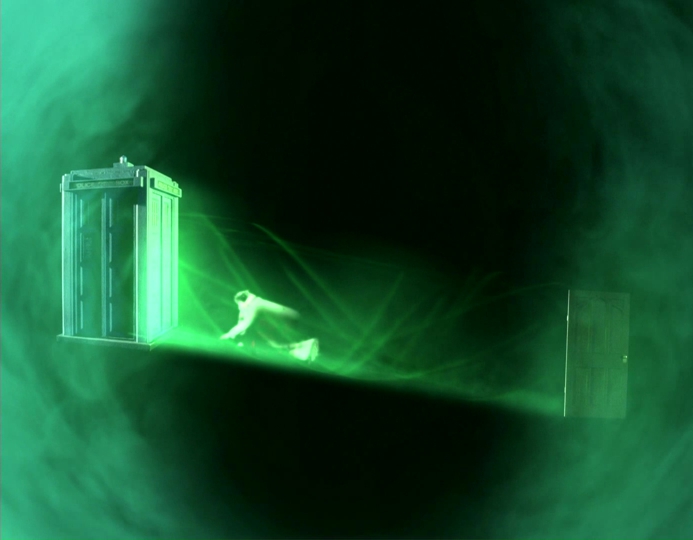
2:01:46 - Clare's hands are burning
• CHARLES NORTON:
Although this scene was shot as planned during studio recording at Television Centre in 1979, a few months later, the decision was taken not to include it in the final edit. Had Shada been completed as a four-part serial for broadcast in 1981 (which was the last time it was worked on prior to Tom Baker leaving Doctor Who), then this scene of Clare burning her hand would have ended up on the cutting room floor. They planned to retain only a few seconds of the explosion at the end of the scene. All of the material prior to that would have been deleted. It's not known what the thinking was behind this cut, but I suspect it would have been to do with bringing the general running time down.
Although this scene was shot as planned during studio recording at Television Centre in 1979, a few months later, the decision was taken not to include it in the final edit. Had Shada been completed as a four-part serial for broadcast in 1981 (which was the last time it was worked on prior to Tom Baker leaving Doctor Who), then this scene of Clare burning her hand would have ended up on the cutting room floor. They planned to retain only a few seconds of the explosion at the end of the scene. All of the material prior to that would have been deleted. It's not known what the thinking was behind this cut, but I suspect it would have been to do with bringing the general running time down.
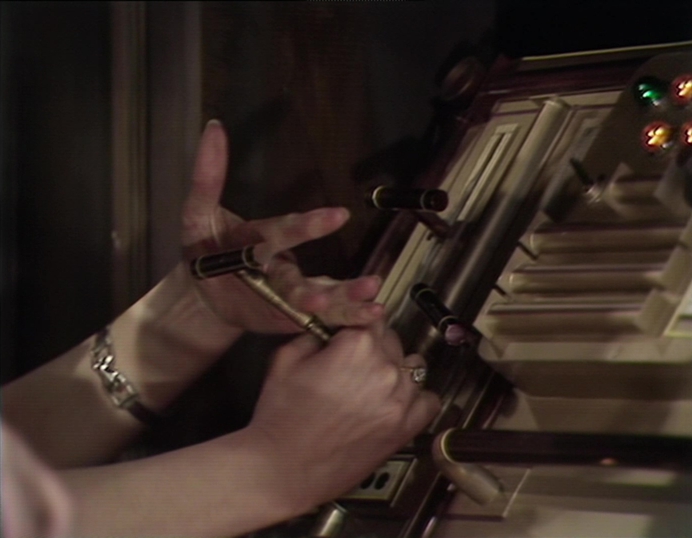
Original vortex sequence recorded back in 1979
2:02:14 - The TARDIS spins away
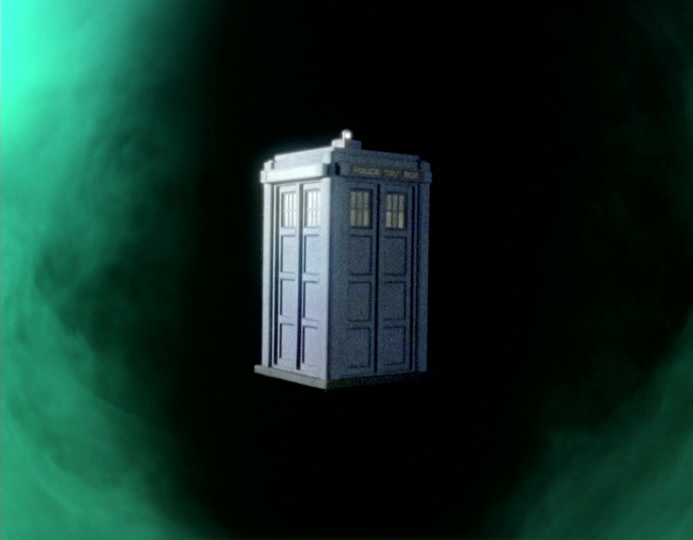
• CHARLES NORTON:
The TARDIS miniature has been set spinning (by Mike Tucker) just before the camera rolled. The camera is on a little wheeled trolley (on which sits director of photography Peter Tyler) and it is pulled backwards by the focus puller (Chris Hayden) along a camera track - which is like a small railway track laid out on the floor. So the TARDIS isn't moving away from the camera, the camera is moving away from the TARDIS. Again, all done on 16mm film, with the TARDIS suspended upside down on a wire.
The TARDIS miniature has been set spinning (by Mike Tucker) just before the camera rolled. The camera is on a little wheeled trolley (on which sits director of photography Peter Tyler) and it is pulled backwards by the focus puller (Chris Hayden) along a camera track - which is like a small railway track laid out on the floor. So the TARDIS isn't moving away from the camera, the camera is moving away from the TARDIS. Again, all done on 16mm film, with the TARDIS suspended upside down on a wire.
2:02:18 - The Doctor falls away
• CHARLES NORTON:
A similar set of effects are being deployed here as were used in the crawling shots. However, it's a bit more complex than before. Tim (dressed as Tom) is sitting on a small stool, with a green screen behind him and the green stocking mask on. He waggles his legs and arms, as if he is falling through space, just as the camera (operated by John Kelly) pulls back away from him. To create the impression of the Doctor's scarf fluttering as he falls, the scarf has had stiff wires connected to it at either side. These wires are then puppeteered by our veteran effects specialists Mike Tucker and Mat Irvine. Mike is operating the screen-left bit of scarf and Mat is screen-right. The head is then digitally removed and replaced with our life-size Tom sculpt. Michael also added some motion blur to the footage in post. The overall effect is hopefully of the Doctor falling away from us, even though Tim isn't actually moving away from us at all. It's just the camera pulling away from him.
A similar set of effects are being deployed here as were used in the crawling shots. However, it's a bit more complex than before. Tim (dressed as Tom) is sitting on a small stool, with a green screen behind him and the green stocking mask on. He waggles his legs and arms, as if he is falling through space, just as the camera (operated by John Kelly) pulls back away from him. To create the impression of the Doctor's scarf fluttering as he falls, the scarf has had stiff wires connected to it at either side. These wires are then puppeteered by our veteran effects specialists Mike Tucker and Mat Irvine. Mike is operating the screen-left bit of scarf and Mat is screen-right. The head is then digitally removed and replaced with our life-size Tom sculpt. Michael also added some motion blur to the footage in post. The overall effect is hopefully of the Doctor falling away from us, even though Tim isn't actually moving away from us at all. It's just the camera pulling away from him.
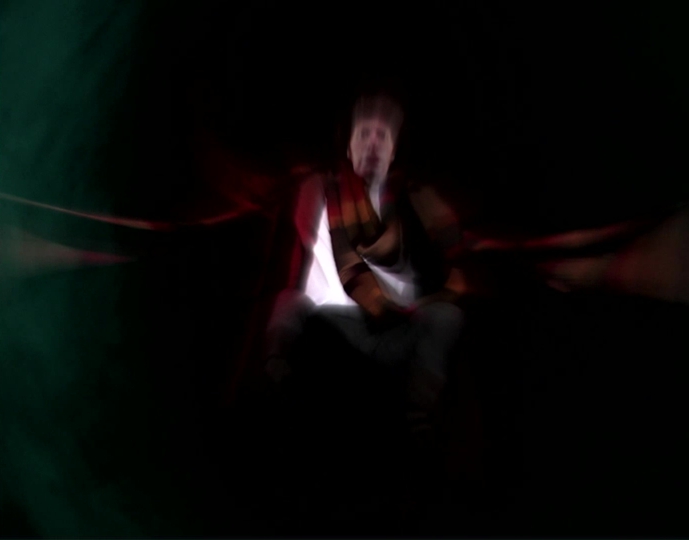
2:02:20 - Skagra doesn't gloat over the Doctor's death
• CHARLES NORTON:
As first scripted, there was a short scene in the TARDIS after the Doctor falls into the void. It would have seen Skagra saying how pleased he was about the Doctor's demise. We decided not to record it. Our reasoning was much the same as it was with the last cut scene.
As first scripted, there was a short scene in the TARDIS after the Doctor falls into the void. It would have seen Skagra saying how pleased he was about the Doctor's demise. We decided not to record it. Our reasoning was much the same as it was with the last cut scene.
2:02:53 - K9 completes his repairs
• CHARLES NORTON:
This little bit at the end of the scene, with K9 saying he's completed his repairs was originally scripted to come significantly later in the story. It was going to be the start of a second shorter scene with Clare and Romana that came after the Doctor's material back on board the TARDIS. In the edit, I moved this sequence back and tacked it onto the end of this earlier Clare and Romana scene.
This little bit at the end of the scene, with K9 saying he's completed his repairs was originally scripted to come significantly later in the story. It was going to be the start of a second shorter scene with Clare and Romana that came after the Doctor's material back on board the TARDIS. In the edit, I moved this sequence back and tacked it onto the end of this earlier Clare and Romana scene.
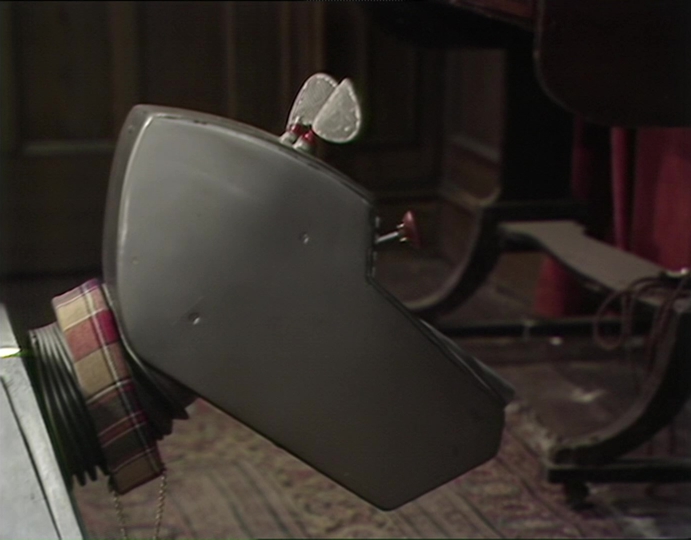
2:03:18 - The Doctor crashes back aboard the TARDIS
• CHARLES NORTON:
The background painting is by Colin Howard here. And as you can see, the set has been liberally dressed with a variety of era-appropriate props. The brief was to include as much junk as the original production team might have been able to have found in storage at the time Shada was originally in production. So, mostly props from the 1970s, especially the late 70s and nothing post 1979. If you look very closely, you'll catch a glimpse of Orac from Blake's 7 too.
The background painting is by Colin Howard here. And as you can see, the set has been liberally dressed with a variety of era-appropriate props. The brief was to include as much junk as the original production team might have been able to have found in storage at the time Shada was originally in production. So, mostly props from the 1970s, especially the late 70s and nothing post 1979. If you look very closely, you'll catch a glimpse of Orac from Blake's 7 too.
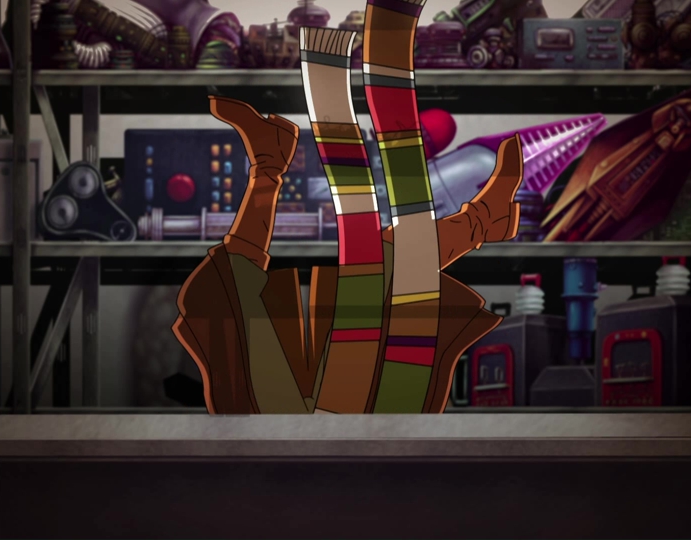
2:04:41 - The Doctor doesn't spend more time working on the helmet
• CHARLES NORTON:
The original 1979 rehearsal script spends an awful lot more time on the Doctor building his helmet than we do in the final version of the programme. As originally scripted, there's a big chunk of material (five pages worth) that comes after Skagra's talk of "an infinite concert of the mind" and before the Doctor re-enters the TARDIS control room. In this scene, the Doctor is mostly working on building the helmet in the TARDIS workshop. Essentially that was just some more of the Doctor tinkering with tools and gadgets and more of him talking to himself, picking bits up and slowly building the helmet.
It's an odd bit of padding to put in at such a tense moment, so close to the finale. As it is merely the Doctor doing some more of something that we've already seen him do a scene earlier, we made the decision not to include it.
The material would never have made it to television back in the day either, for what it's worth, or at least, not in full. The scene is heavily reduced to just a few seconds in Pennant Roberts' 1979 camera script and it was shortened still further in the last 1980 draft of the camera script. So, it wasn't just me. Pennant Roberts clearly didn't think it worked either.
The original 1979 rehearsal script spends an awful lot more time on the Doctor building his helmet than we do in the final version of the programme. As originally scripted, there's a big chunk of material (five pages worth) that comes after Skagra's talk of "an infinite concert of the mind" and before the Doctor re-enters the TARDIS control room. In this scene, the Doctor is mostly working on building the helmet in the TARDIS workshop. Essentially that was just some more of the Doctor tinkering with tools and gadgets and more of him talking to himself, picking bits up and slowly building the helmet.
It's an odd bit of padding to put in at such a tense moment, so close to the finale. As it is merely the Doctor doing some more of something that we've already seen him do a scene earlier, we made the decision not to include it.
The material would never have made it to television back in the day either, for what it's worth, or at least, not in full. The scene is heavily reduced to just a few seconds in Pennant Roberts' 1979 camera script and it was shortened still further in the last 1980 draft of the camera script. So, it wasn't just me. Pennant Roberts clearly didn't think it worked either.
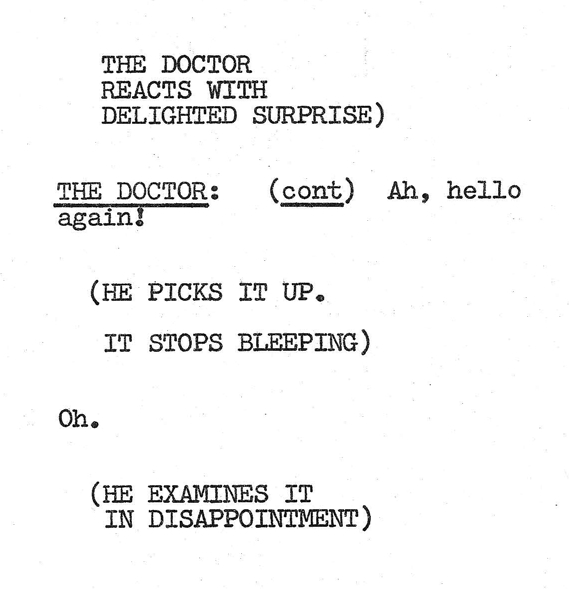
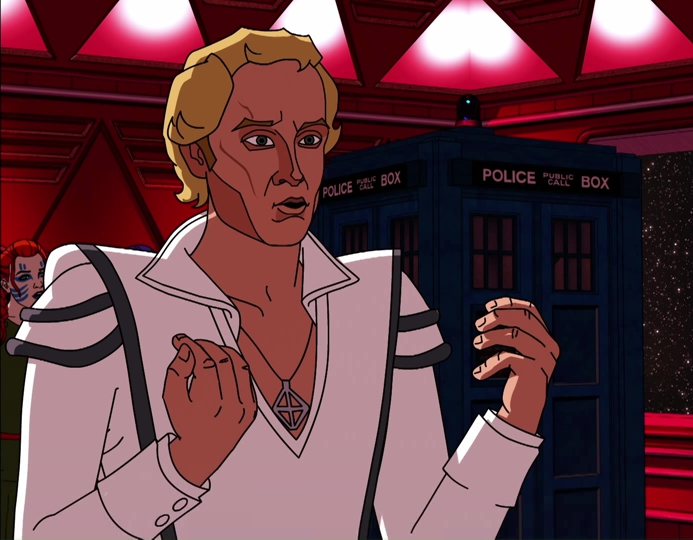
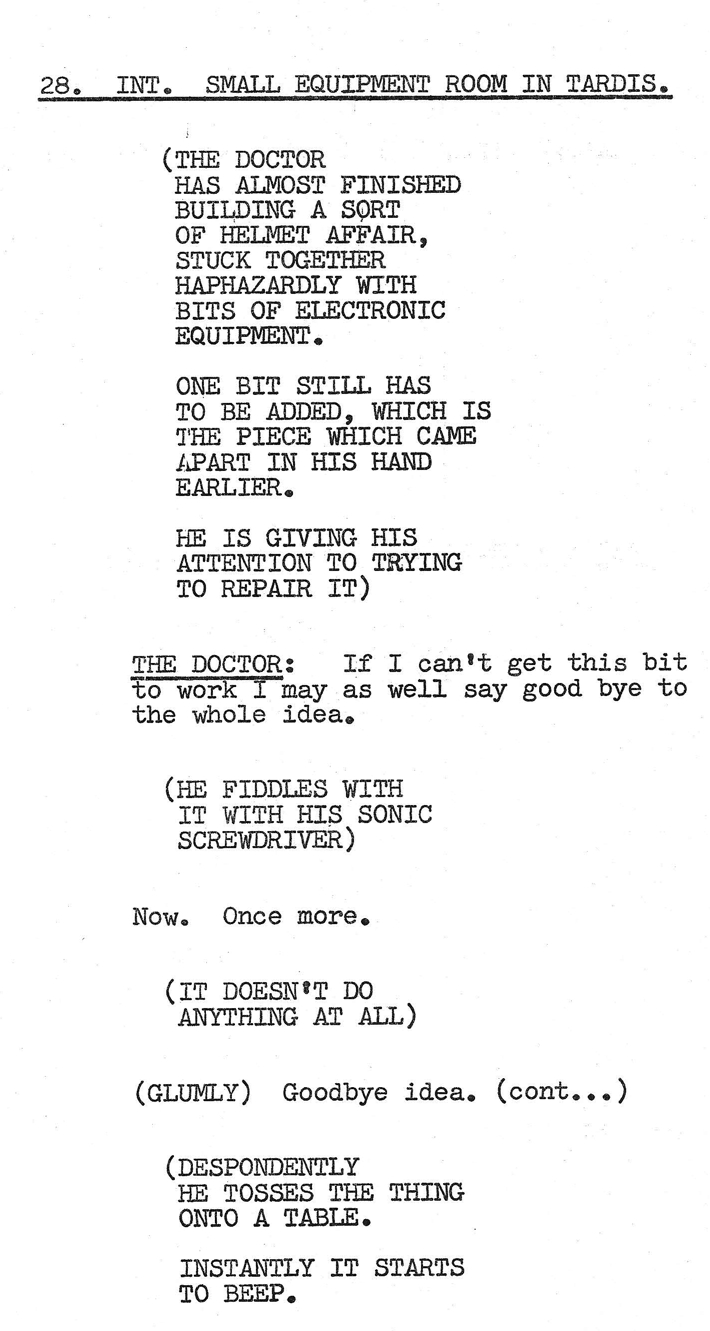
2:05:28 - "Out you come"
• CHARLES NORTON:
Skagra's call to the Doctor to come out of the Professor's TARDIS was originally part of an earlier scripted scene that we never recorded. However, I liked this one line and so moved it out of that cut material and put it here, to open this scene instead.
Skagra's call to the Doctor to come out of the Professor's TARDIS was originally part of an earlier scripted scene that we never recorded. However, I liked this one line and so moved it out of that cut material and put it here, to open this scene instead.
2:05:44 - Skagra stands on the command deck with the prisoners
• CHARLES NORTON:
There's a long-standing rumour that, back in 1979, the original intention was for all the Shada prisoners to be represented by old monsters from the Doctor's past, the logic being that re-using old costumes would be cheaper than making new ones. So, the prisoners of Shada would have supposedly included a Dalek, a Zygon and a Cyberman. The only thing is, this rumour is complete nonsense. It never happened.
The original 1979 rehearsal script only mentions "assorted criminals" and "Zombie-like prisoners." The camera script meanwhile contains no mention of the prisoners at all, as there are no camera script pages for any of the scenes set on Shada. The one document that does mention the prisoners in detail is a recording schedule, typed up for a late November shoot in studio TC6 (that ultimately ended up never happening). This document not only breaks down exactly how many prisoners the production team intended there to be, but also gives us an indication of who each prisoner was and what they might have looked like. According to this document, the full list of the Shada prisoners was as follows: "Lucretia Borgia, Boedicia, Lady Macbeth, Salome, executioner, Rasputin, Nero, a gladiator, Genghis Khan, space monster, space monster and space monster." And yes, that's three space monsters.
For the animation, we didn't really have the resources to create that large a number of characters. Extras were cheaper to hire in 1979 than they were to draw in 2017. However, we did base each one of our prisoners on that 1979 recording schedule listing. So we created a Boedicia (sic), a Genghis Khan, a Rasputin, a Nero and three space monsters. We omitted Lucretia Borgia, Lady Macbeth, Salome, the executioner and the gladiator.
You also might be able to see that the look of our Rasputin is based on the appearance of Tom Baker playing the part of Rasputin in the 1971 film Nicholas and Alexandra. And our Nero is based on the appearance of actor Derek Francis, when he played the part of the emperor in the 1965 Doctor Who story, The Romans. The three space monsters are all from the imagination of Martin Geraghty, but designed to feel like the kind of thing that could have been created by a BBC production team in 1979.
• MARTIN GERAGHTY:
The design of the Shada inmates was a particularly interesting part of recreating this story. I just designed characters that would’ve been achievable to the production team in 1979, re-using elements from Bruce Purchase’s Pirate character for the Cyborg, for example or utilising something that John Friedlander may have conjured up in 1979. The new design work I was required to do always bore in mind the design style of that era of the show, including the mad lash-up headgear the Doctor creates.
• ADRIAN SALMON:
Martin Geraghty designed eight prisoners of Shada, the more infamous were Rasputin, Ghengis Kahn, Nero and the Iceni queen Boudicca, to a number of original alien convicts. They all wore the same basic khaki prison suit, but each needed their individual details colouring. Boudicca was covered in blue wode tattoos, whilst blond Nero was given a sunburned complexion. One alien had purple skin with white eyes, which we naturally christened ‘white eyes’! A colour guide was put together with them all on one sheet, like a police line-up.
• CHARLES NORTON:
Of course, if the prison line-up was so clearly set down in the paperwork back in 1979, where does that odd rumour come from about the Daleks and all those other old baddies being among the prisoners? Back in the early 80s, when the internet largely didn't exist and Doctor Who Monthly was only half its present size, information about the making of the mythical Shada was rather hard to come by. People would try and piece things together as best they could from snatches of cast interviews and fuzzy publicity photographs in Peter Haining books. And where there were gaps in the information, people would either make inspired guesses or they'd just make stuff up.
• RICHARD BIGNELL:
Whilst the notion that Shada would have featured old monsters is something that has been repeated many times over the years, the earliest printed form of the rumour stems back to October 1980 and Issue 45 of Doctor Who Monthly. The issue contained a three-page article entitled Shada: The Lost Story – A Final Retreat that had been written a few weeks after the plan to resurrect the story as a two-part Christmas special had been formally abandoned in late June. The unattributed piece was actually written by the magazine’s then feature writer, Jeremy Bentham. “It certainly wasn’t creative licence in namechecking those three old monsters,” recalls Bentham. “The reference is far too precise for that.” Having looked through his diaries for 1979, Bentham has not been able to find anything concrete, but he was able to locate two entries in the late November and early December of that year (at the time when the latter studio sessions of Shada were being cancelled) where the expectation of returning monsters was briefly referred to during his meetings with other fans.
The idea wasn’t without precedent, of course, as a Wirrn costume from The Ark in Space and an android from The Android Invasion had briefly been seen among the dead prisoners on board the spaceship in The Stones of Blood the previous year (the use of a Sea Devil had also been cleared with Malcolm Hulke, but was ultimately not used), so there may have been the anticipation amongst fans that something similar might happen again.
There's a long-standing rumour that, back in 1979, the original intention was for all the Shada prisoners to be represented by old monsters from the Doctor's past, the logic being that re-using old costumes would be cheaper than making new ones. So, the prisoners of Shada would have supposedly included a Dalek, a Zygon and a Cyberman. The only thing is, this rumour is complete nonsense. It never happened.
The original 1979 rehearsal script only mentions "assorted criminals" and "Zombie-like prisoners." The camera script meanwhile contains no mention of the prisoners at all, as there are no camera script pages for any of the scenes set on Shada. The one document that does mention the prisoners in detail is a recording schedule, typed up for a late November shoot in studio TC6 (that ultimately ended up never happening). This document not only breaks down exactly how many prisoners the production team intended there to be, but also gives us an indication of who each prisoner was and what they might have looked like. According to this document, the full list of the Shada prisoners was as follows: "Lucretia Borgia, Boedicia, Lady Macbeth, Salome, executioner, Rasputin, Nero, a gladiator, Genghis Khan, space monster, space monster and space monster." And yes, that's three space monsters.
For the animation, we didn't really have the resources to create that large a number of characters. Extras were cheaper to hire in 1979 than they were to draw in 2017. However, we did base each one of our prisoners on that 1979 recording schedule listing. So we created a Boedicia (sic), a Genghis Khan, a Rasputin, a Nero and three space monsters. We omitted Lucretia Borgia, Lady Macbeth, Salome, the executioner and the gladiator.
You also might be able to see that the look of our Rasputin is based on the appearance of Tom Baker playing the part of Rasputin in the 1971 film Nicholas and Alexandra. And our Nero is based on the appearance of actor Derek Francis, when he played the part of the emperor in the 1965 Doctor Who story, The Romans. The three space monsters are all from the imagination of Martin Geraghty, but designed to feel like the kind of thing that could have been created by a BBC production team in 1979.
• MARTIN GERAGHTY:
The design of the Shada inmates was a particularly interesting part of recreating this story. I just designed characters that would’ve been achievable to the production team in 1979, re-using elements from Bruce Purchase’s Pirate character for the Cyborg, for example or utilising something that John Friedlander may have conjured up in 1979. The new design work I was required to do always bore in mind the design style of that era of the show, including the mad lash-up headgear the Doctor creates.
• ADRIAN SALMON:
Martin Geraghty designed eight prisoners of Shada, the more infamous were Rasputin, Ghengis Kahn, Nero and the Iceni queen Boudicca, to a number of original alien convicts. They all wore the same basic khaki prison suit, but each needed their individual details colouring. Boudicca was covered in blue wode tattoos, whilst blond Nero was given a sunburned complexion. One alien had purple skin with white eyes, which we naturally christened ‘white eyes’! A colour guide was put together with them all on one sheet, like a police line-up.
• CHARLES NORTON:
Of course, if the prison line-up was so clearly set down in the paperwork back in 1979, where does that odd rumour come from about the Daleks and all those other old baddies being among the prisoners? Back in the early 80s, when the internet largely didn't exist and Doctor Who Monthly was only half its present size, information about the making of the mythical Shada was rather hard to come by. People would try and piece things together as best they could from snatches of cast interviews and fuzzy publicity photographs in Peter Haining books. And where there were gaps in the information, people would either make inspired guesses or they'd just make stuff up.
• RICHARD BIGNELL:
Whilst the notion that Shada would have featured old monsters is something that has been repeated many times over the years, the earliest printed form of the rumour stems back to October 1980 and Issue 45 of Doctor Who Monthly. The issue contained a three-page article entitled Shada: The Lost Story – A Final Retreat that had been written a few weeks after the plan to resurrect the story as a two-part Christmas special had been formally abandoned in late June. The unattributed piece was actually written by the magazine’s then feature writer, Jeremy Bentham. “It certainly wasn’t creative licence in namechecking those three old monsters,” recalls Bentham. “The reference is far too precise for that.” Having looked through his diaries for 1979, Bentham has not been able to find anything concrete, but he was able to locate two entries in the late November and early December of that year (at the time when the latter studio sessions of Shada were being cancelled) where the expectation of returning monsters was briefly referred to during his meetings with other fans.
The idea wasn’t without precedent, of course, as a Wirrn costume from The Ark in Space and an android from The Android Invasion had briefly been seen among the dead prisoners on board the spaceship in The Stones of Blood the previous year (the use of a Sea Devil had also been cleared with Malcolm Hulke, but was ultimately not used), so there may have been the anticipation amongst fans that something similar might happen again.
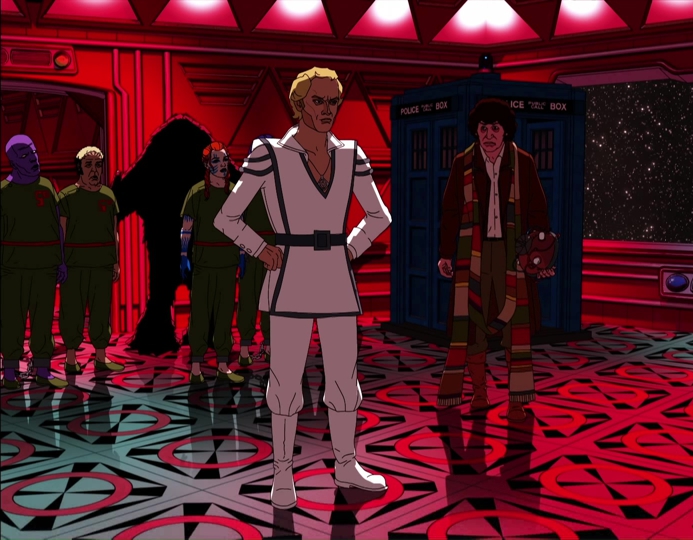
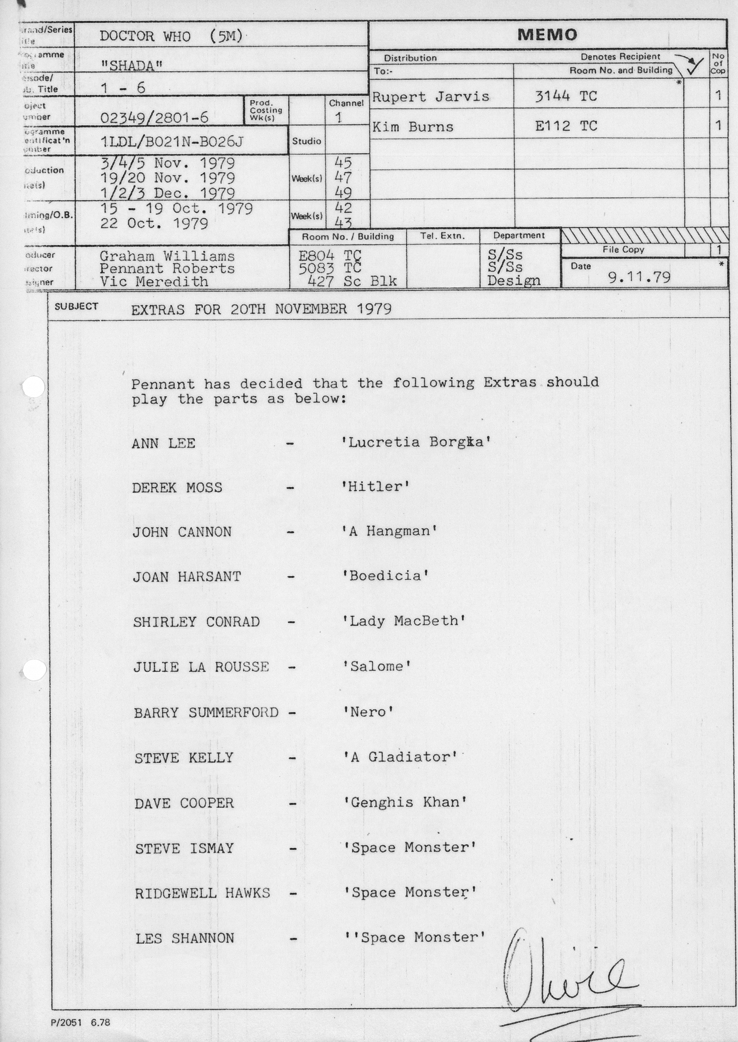
2:06:24 - The prisoners advance on Skagra
• CHARLES NORTON:
One of the final bits of post-production on Shada was the dubbing and mixing of the sound effects and music. Mark Ayres had frighteningly little time to complete this and worked through the night to do so. I joined him at his studio on 8th November to sit down with him and go through the dub.
It was a very long day and we were both a bit sleep deprived too, which didn't help. It was during the scene of the prisoners advancing on Skagra that I realised the chains on their feet weren't making any noise. And logic would suggest that if you've got your feet in chains, they'd make some noise when you walked. As Mark had already been up all the previous night recording the sounds of tin cans rolling onto his kitchen floor (for the scene of the Doctor making his helmet), I felt more than a little guilty in asking him to do yet another Foley session for the chains. But I did it anyway. I then almost immediately buggered off to get my train home and left him to yet another night's work without any sleep. We got the clanging chains though and you can hear them here, as the prisoners march about on the Krarg carrier ship.
One of the final bits of post-production on Shada was the dubbing and mixing of the sound effects and music. Mark Ayres had frighteningly little time to complete this and worked through the night to do so. I joined him at his studio on 8th November to sit down with him and go through the dub.
It was a very long day and we were both a bit sleep deprived too, which didn't help. It was during the scene of the prisoners advancing on Skagra that I realised the chains on their feet weren't making any noise. And logic would suggest that if you've got your feet in chains, they'd make some noise when you walked. As Mark had already been up all the previous night recording the sounds of tin cans rolling onto his kitchen floor (for the scene of the Doctor making his helmet), I felt more than a little guilty in asking him to do yet another Foley session for the chains. But I did it anyway. I then almost immediately buggered off to get my train home and left him to yet another night's work without any sleep. We got the clanging chains though and you can hear them here, as the prisoners march about on the Krarg carrier ship.
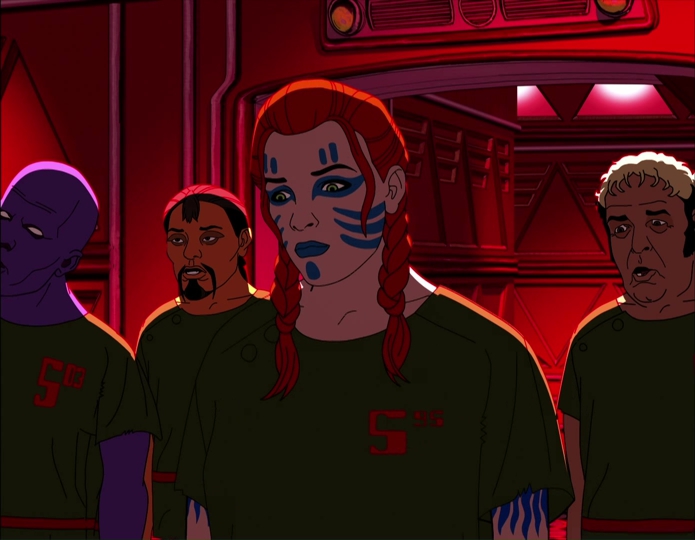
2:09:25 - Skagra runs away
• CHARLES NORTON:
We used a frame-rate motion estimation plug-in to add extra fluidity to this shot of Skagra running away. Most of the time when we used this plug-in, it went horribly wrong, but on this occasion, it worked really well. Helped, of course, by excellent underlying character animation from AnneMarie Walsh.
We used a frame-rate motion estimation plug-in to add extra fluidity to this shot of Skagra running away. Most of the time when we used this plug-in, it went horribly wrong, but on this occasion, it worked really well. Helped, of course, by excellent underlying character animation from AnneMarie Walsh.
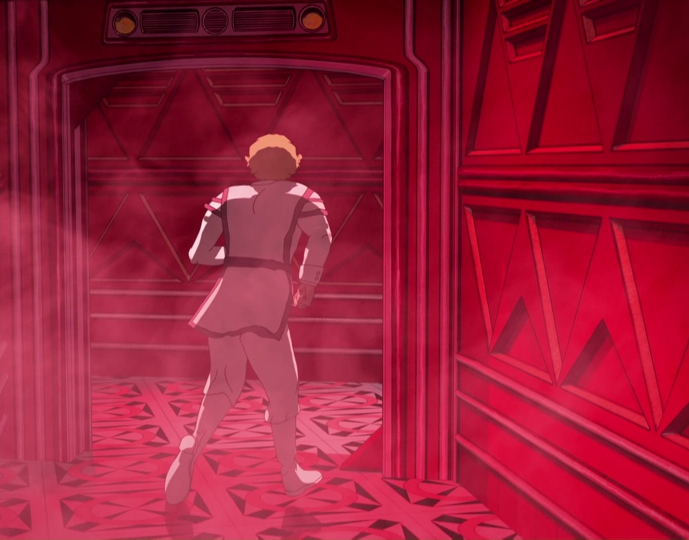
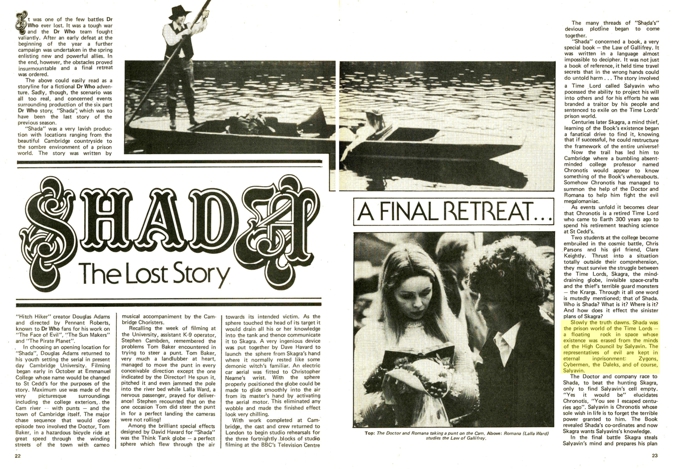
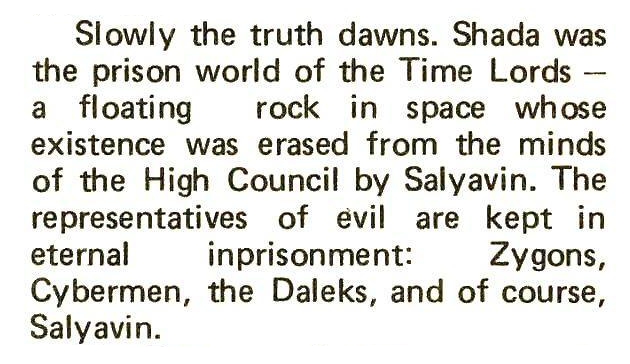
The six surviving production files for the story in the BBC Written Archives make do make reference a number of times to the “space monster” prisoners of Shada, but they never once mention the reuse of any old costumes. Given that the three actors playing the monsters were due to be in studio during the second day of the first cancelled studio session, decisions would certainly have been finalised as to what costumes they would be wearing for the recording. Certainly, if a Dalek was planned to be used, it would also be expected that advance clearance would have been sort from Terry Nation as it was for The Five Doctors three years later. But there is nothing in the files.
Steve Ismay is the only one of the three original actors hired to play the “space monsters” that is still alive. Ismay played many small roles in the series throughout the 1970s, starting with The Daemons in 1971. As well as appearing a numerous soldiers, guards and scientists, he also played a number of monsters as well, notably a Sea Devil, an Exxilon and latterly, a Cyberman in Earthshock. Ismay recalls that the costume he was due to wear in Shada was “a heavy suit with a large, black monster face” and it’s notable that he was also paid to attend a wig fitting for his role on 12 November 1979, in advance of his first studio day. These details suggest that whatever “space monster” Ismay was due to play, it evidently wasn’t one of the aforementioned creatures.
Steve Ismay is the only one of the three original actors hired to play the “space monsters” that is still alive. Ismay played many small roles in the series throughout the 1970s, starting with The Daemons in 1971. As well as appearing a numerous soldiers, guards and scientists, he also played a number of monsters as well, notably a Sea Devil, an Exxilon and latterly, a Cyberman in Earthshock. Ismay recalls that the costume he was due to wear in Shada was “a heavy suit with a large, black monster face” and it’s notable that he was also paid to attend a wig fitting for his role on 12 November 1979, in advance of his first studio day. These details suggest that whatever “space monster” Ismay was due to play, it evidently wasn’t one of the aforementioned creatures.
